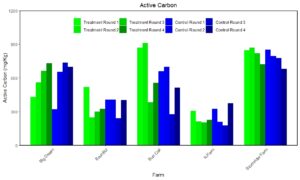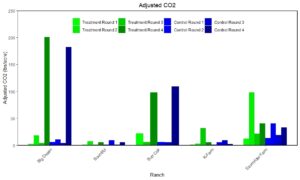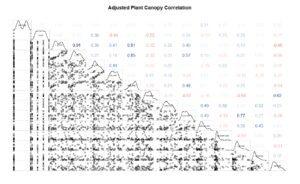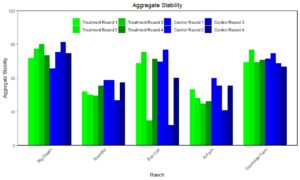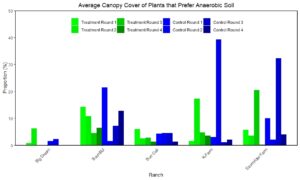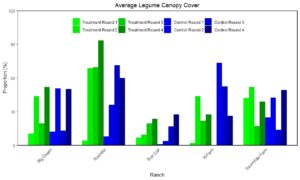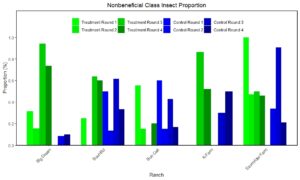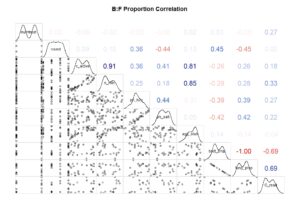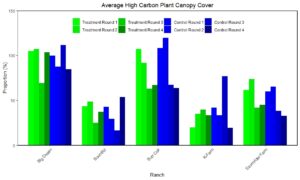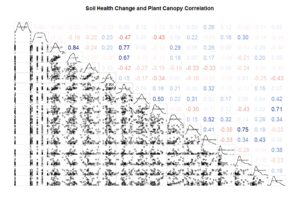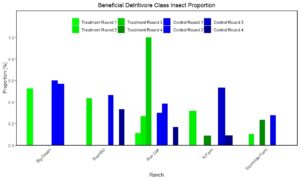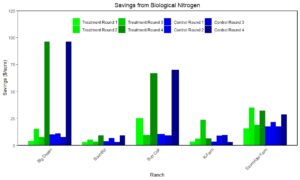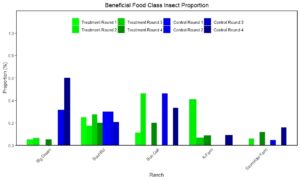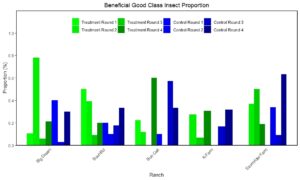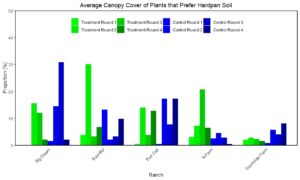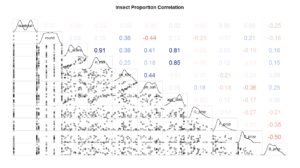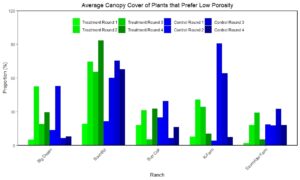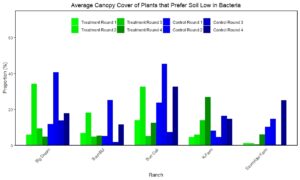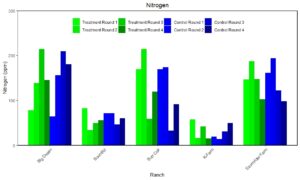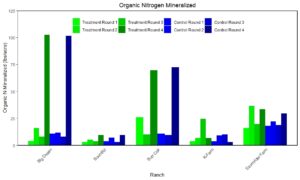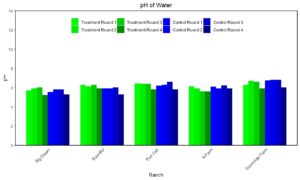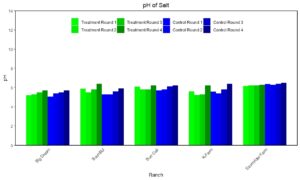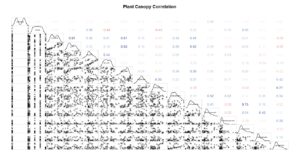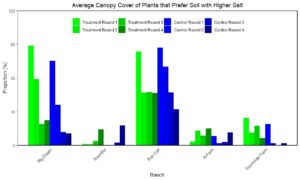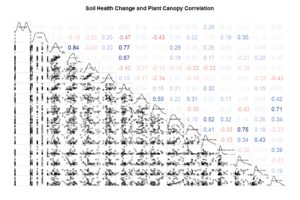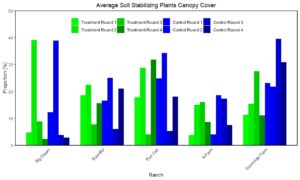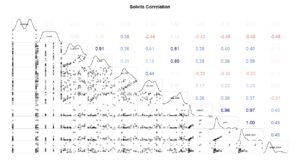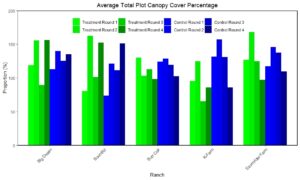Final report for FNC20-1224
Project Information
There are 5 ranches involved in FNC20-1224 within 2 counties of the West Central Region of Missouri. Three locations are livestock only and two are fruit, vegetables, flower and livestock diversified operations. One of the diversified ranches uses organic practices but is not certified (Burr Oak Farm, 78 acres), and the other has been using regenerative practices for 4 years (Bountiful, 5 acres). One of the livestock only ranches has been using regenerative practices for 5 years (Storm Rider, 40 acres). The other two livestock grazing ranches are just beginning to look into regenerative practices (Big Dream, 19.5 acres and K-Farm, 3acres). Soil health has been an active focus for three of the properties to varying degrees. Burr Oak uses organic practices to grow flowers, fruit and vegetables under plastic culture (3 hightunnels) and open field vegetable production with fescue pastures using adaptive grazing techniques. Bountiful is a poultry and sheep ranch of highly diverse pasture with plastic culture (ventilated overhead hightunnel) production for vegetables. Storm Rider is a diversified pasture reclaimed from corn and bean rotation by using cover crop cocktails to over seed mixed weed fields. Learning about regenerative practices is the focus of K-Farm and Big Dream. K-Farm has a small fruit orchard grazed by sheep plus some very brittle and weedy land reclaimed from a house construction site providing some of their grazing. K-farm uses no chemicals in the orchard allowing tall grasses to protect the fruit from deer (deer prefer to know where they are jumping). The sheep graze the orchard in spring and prior to fruit harvest. Big Dream has sheep, goats and alpacas for fiber, poultry for eggs and meat, plus a milk cow and small garden for family use as well as fescue hay fields. They struggle with overgrazed pastures due to keeping all species separate and boarding a couple of horses for neighbors; as well as having only a portion of the property in permanent fencing to allow for hay production.
Changing Climate and increasing input costs combine to stress farmers ecologically, economically, and socially. Regenerative grazing practices leading to better soil health can help farmers by increasing pasture biodiversity resulting in resilience to climate changes, reducing pasture input needs, increasing water storage capacity and reducing time farmers spend applying inputs. Measuring soil health is both costly and time consuming. We propose to assess whether wild forb and insect biodiversity and abundance can be used as surrogates in measuring soil health on farms where regenerative methods have been practiced for several years and where they are newly implemented. Cover crops will be used to improve soil health which should stimulate wild forb growth and insect species utilization of pastures. We will utilize modified Daubenmire frames to measure vegetation cover and species. We will measure insect diversity and abundance using sweep-net transects. Vegetation and insect measurements will be related to soil health measurements. We expect that increasing soil health will increase wild forb and insect biodiversity and abundance, while increased soil organic matter (soil carbon) would indicate greater water storage capacity.
-
- Utilize soil health analysis to compare soil health under regenerative practices long term to short term and to traditional small farm pasture management
- Utilize soil health analysis to quantify changes in soil health between years at each site
- Plant cover crops to help improve the soil health on five farms
- Collect and inventory insects and plants to compare five farms
- Use Solvita CO2 test after grazing to quantify possible carbon sequestration representing water storage capacity
- Use the MicroBiometer test to show fungi to bacteria ratios in test plots (we did not know this test kit existed until the project began-and due to Covid-19 restrictions we did not spend much of our grant money and shifted some funds to purchase a kit/farm) We will compare test to control plots and farm to farm fungi to bacteria levels under regenerative practices.
Cooperators
- - Producer
- - Producer
- - Producer
- - Producer
Research
5 ranchers on 5 tiny ranches 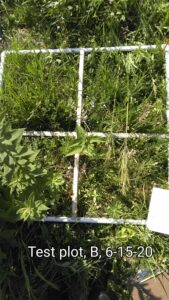
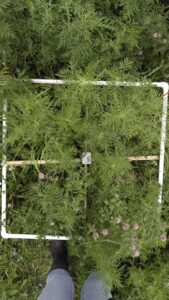
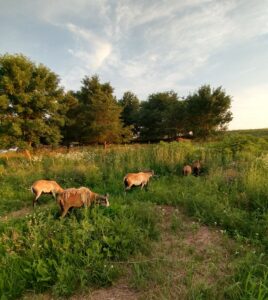
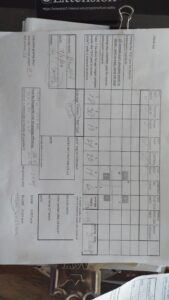
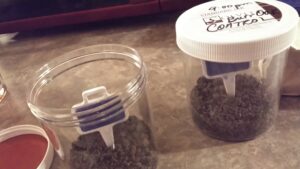
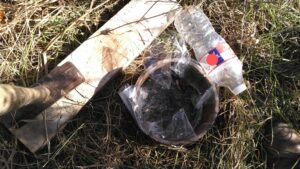
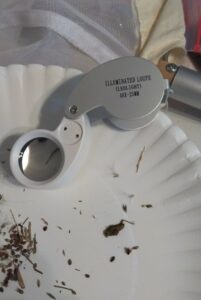
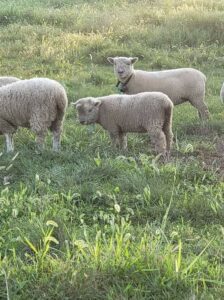 Soil health analysis will be used to understand active carbon, mineralizable nutrients, organic matter of each farm’s soil to compare the farms. All 5 farms have small ruminants to graze the cover crops but the farms are at different stages of regenerative practices. All the farms, at some point in their history, have been under traditional chemical farming. All the farms have experienced the extremes of drought and extensive flooding in the past 5-6 years. We want to know how the regenerative practices will help us keep our soil and feed our animals. Water infiltration and Solvita CO2 testing will help us understand how much water holding capacity we have in our soils to withstand flood or drought for climate change resilience. Collecting inects and quantifying wild forbs will show us if we have genuine diversity and free ecoservices from this diversity. We will collect insects using sweep-nets along four -five meter transects on a 50m by 100m grid. We will measure vegetation at points on a 50m by 50m grid. Soil samples will consist of one sample submitted per test plot and one per control plot per project stage (prior to cover crop planting/grazing, post planting/grazing each year). In each field we will collect soil at each vegetation measurement point and combine it to one sample to represent the field average in the test plot and control plot. The test plot will be grazed and the control plot will not be grazed. We will then relate diversity and abundance measurements to soil health analysis between and among our fields.
Soil health analysis will be used to understand active carbon, mineralizable nutrients, organic matter of each farm’s soil to compare the farms. All 5 farms have small ruminants to graze the cover crops but the farms are at different stages of regenerative practices. All the farms, at some point in their history, have been under traditional chemical farming. All the farms have experienced the extremes of drought and extensive flooding in the past 5-6 years. We want to know how the regenerative practices will help us keep our soil and feed our animals. Water infiltration and Solvita CO2 testing will help us understand how much water holding capacity we have in our soils to withstand flood or drought for climate change resilience. Collecting inects and quantifying wild forbs will show us if we have genuine diversity and free ecoservices from this diversity. We will collect insects using sweep-nets along four -five meter transects on a 50m by 100m grid. We will measure vegetation at points on a 50m by 50m grid. Soil samples will consist of one sample submitted per test plot and one per control plot per project stage (prior to cover crop planting/grazing, post planting/grazing each year). In each field we will collect soil at each vegetation measurement point and combine it to one sample to represent the field average in the test plot and control plot. The test plot will be grazed and the control plot will not be grazed. We will then relate diversity and abundance measurements to soil health analysis between and among our fields.
Note: We added the MicroBiometer.com Test after we accidentally discovered it at the Fuller Field School in Kansas, when Dr. Jill Clapperton introduced the product she developed. This soil test will measure the fungus to bacteria ratio and uses a phone app to read the test card. Since mycorrhizal fungi play an important role in soil health, we felt that we could show a gain or loss of fungi either seasonally or year to year with regenerative grazing practices.
Solvita Tests: Dr. Clapperton also recommended a different method of using the Solvita test in the field. She suggested that we not bother with sieving the soil, in fact do not collect soil samples at all. In the test and control plots, stab the test paddle into the soil and screw the sample container into the ground over the paddle and mark it, come back in 24 hours to read the test. I discovered that the Solvita test paddles are not very stable if exposed to high temperatures even while in the package. 2 of the packages were ruined due to condensation. These paddles are a bit pricey, I would recommend purchasing only the amount of paddles needed for the first year and then purchase more for the second year of your grant and keep them in a climate controlled area. Use a cooler with cold packs while in the field-before opening. We used the paper color chart which is included in the field kit, the jars and rubber disks inside the lid maybe washed and used again. We just used tape on the lid to write the time and name of farm.
Water infiltration: We used a 6-inch long x 6-inch diameter piece of metal pipe to beat into the ground with a sledge hammer, placed a one foot length of kitchen plastic wrap down in the pipe to catch and hold 15 ounces of water until we were ready to start a stop-watch. We then pulled the plastic wrap out and noted how long the water took to soak into the soil in test and control plots.
We used a meter by meter squares divided into 4 segments to access percentages of wild forbs and cover crops present in 4 transects of the test and control plots on each farm. These transects were marked and observed 4 times on each farm, placing the meter squares in the same place each time for observation. Between the transects, a path was followed in the same direction each time we sampled to use a sweep net to collect insects, we did this first-before laying our meter squares out-to prevent flushing the insects out of the sample area. Insects were later identified as "good bugs" -pollinators and predators, "food" -for other species, "detritivores"-decomposers, and "bad bugs"-non-beneficial insects. We also noted how many of each were caught.
| Spring 2020 Cover Crops | Fall 2020 Cover Crops | Spring Cover Crops 2021 | Fall Cover Crops 2021 |
| Sorghum Sudangrass | Annual Ryegrass | Oats | Oats |
| Hybrid Pearl Millet | Spring Oats | BMR Sorghum Sudan | Forage Wheat |
| Japanese Millet | Cereal Rye | Japanese Millet | Barley |
| Teff Grass | Winter Peas | Hybrid Pearl Millet | Rye |
| Mung Beans | Spring Peas | Forage Peas | Winter Peas |
| Lespedeza | Crimson Clover | Laredo Haybeans | Crimson Clover |
| Sunflower | Balansa Clover | Buckwheat | Balansa Clover |
| Buckwheat | Radish | Sunflower | Vetch |
| Inoculant | Rapeseed | Sweet Clover | Rape |
| Turnip | Sugar Beets | Radish | |
| Hairy Vetch | Brassica | Collards | |
| Inoculant | Inoculant | Hybrid Brassica | |
| Orchard Grass | |||
| Timothy | |||
| Chicory | |||
| Cover Crops used | Sweet Clover | ||
| Alsike Clover | |||
| Ladino Clover | |||
| Inoculant |
| Round 1-wild forbs and Cover crops | test plot | control plot | test plot | control plot | test plot | control plot | test plot | control plot | test plot | control plot | test plot | control plot | test plot | control plot | test plot | control plot | test plot | control plot | test plot | control plot | test plot | control plot | test plot | control plot | test plot | control plot | test plot | control plot | test plot | control plot | test plot | control plot | test plot | control plot | test plot | control plot | test plot | control plot | test plot | control plot | |||||
| name date | Burr Oak, 6/8/21 | Burr Oak, 6/8/21 | Burr Oak, 6/8/21 | Burr Oak, 6/8/21 | Burr Oak, 6/8/21 | Burr Oak, 6/8/21 | Burr Oak, 6/8/21 | Burr Oak, 6/8/21 | name date | K-Farm 6/15/20 | K-Farm, 6/15/20 | k-Farm, 6/15/20 | K-Farm 6/15/20 | K-Farm, 6/15/20 | K-Farm, 6/15/20 | K-Farm, 6/15/20 | K-Farm, 6/15/20 | name date | SRF, 6/20/20 | SRF, 6/20/20 | SRF, 6/20/20 | SRF, 6/20/20 | SRF, 6/20/20 | SRF, 6/20/20 | SRF, 6/20/20 | SRF, 6/20/20 | name date | Bountiful,7/5/20 | Bountiful,7/5/20 | Bountiful,7/5/20 | Bountiful,7/5/20 | Bountiful,7/5/20 | Bountiful,7/5/20 | Bountiful,7/5/20 | Bountiful,7/5/20 | name date | kelly-7/23/20 | kelly-7/23/20 | kelly-7/23/20 | kelly-7/23/20 | kelly-7/23/20 | kelly-7/23/20 | kelly-7/23/20 | kelly-7/23/20 | |
| plot | A | A | B | B | C | C | D | D | plot | A | A | B | B | C | C | D | D | plot | A | A | B | B | C | C | D | D | plot | A | A | B | B | C | C | D | D | plot | A | A | B | B | C | C | D | D | |
| clover, red | 2 | 6 | 30 | 25 | 18 | 3 | 7 | 3 | clover, red | 2 | clover, red | 28 | 18 | 57 | 62 | 36 | 23 | 80 | clover, red | 37 | 25 | 20 | clover, red | 33 | 53 | 44 | 37 | 3 | 9 | 17 | |||||||||||||||
| clover, white | 3 | 12 | 47 | 18 | 5 | 15 | 3 | clover, white | 60 | 47 | 1 | 52 | 35 | 5 | clover, white | 19 | 17 | clover, white | clover, white | ||||||||||||||||||||||||||
| clover, sweet | 2 | clover, sweet | clover, sweet | 3 | clover, sweet | 3 | 15 | 10 | clover, sweet | 2, hop | |||||||||||||||||||||||||||||||||||
| clover, others | clover, others | clover, others | 8, balanca | 1, blanca | clover, others | 79, black medic | 83, black medic | 90, black medic | 16, black medic | 75, black medic | 50, black medic | 70, black medic | 40, black medic | clover, others | 31, black medic | 7, black medic | 79, black medic | 17, black medic | |||||||||||||||||||||||||||
| other legumes | other legumes | other legumes | other legumes | other legumes | |||||||||||||||||||||||||||||||||||||||||
| grass, orchard | grass, orchard | grass, orchard | 3 | grass, orchard | 2 | grass, orchard | |||||||||||||||||||||||||||||||||||||||
| grass, timothy | 5 | grass, timothy | grass, timothy | grass, timothy | grass, timothy | ||||||||||||||||||||||||||||||||||||||||
| grass, blue | 12 | 17 | grass, blue | grass, blue | 3 | 47 | 5 | grass, blue | 20 | grass, blue | |||||||||||||||||||||||||||||||||||
| grass, fescue | 27 | 20 | 20 | 32 | 27 | 25 | 22 | grass, fescue | 3 | 5 | grass, fescue | 6 | grass, fescue | 10 | 15 | grass, fescue | 37 | 42 | 33 | 19 | |||||||||||||||||||||||||
| grass, bermuda | grass, bermuda | 1 | grass, bermuda | grass, bermuda | grass, bermuda | ||||||||||||||||||||||||||||||||||||||||
| grass, rye | 7 | 12 | 15 | 2 | grass, rye | grass, rye | grass, rye | 10 | 10 | grass, rye | |||||||||||||||||||||||||||||||||||
| grass, other | 27, wild oats | 55, wild oats | 30, wild oats | grass, other | grass, other | grass, other | grass, other | ||||||||||||||||||||||||||||||||||||||
| grass, other | grass, other | grass, other | grass, other | grass, other | |||||||||||||||||||||||||||||||||||||||||
| wild forbs | wild forbs | wild forbs | wild forbs | wild forbs | |||||||||||||||||||||||||||||||||||||||||
| golden rod | 8 | 36 | 1 | 2 | 2 | 11 | golden rod | 15 | 1 | golden rod | 2 | 3 | 17 | 3 | 11 | golden rod | 1 | golden rod | |||||||||||||||||||||||||||
| ragweed | 2, giant | 1, common | 3, giant | 4, common | 12, ragweed | 1, common | ragweed | ragweed | 6, common | 5, common | 27, common | 3, common | 23, common | 8, common | 61, common | 3, common | ragweed | ragweed | 77, common | 81, common | 63, common | 13, common | 72, common | 23, common | 27, common | 82, common | |||||||||||||||||||
| wild forbs | 4, sedge | 11 | 2, ground cherry | 25, sour grass | 12, daisy fleabane | 1, elm tree | 3, elm tree | wild forbs | 1, purple stock | 6, daisy fleabane | 1, money plant | 4, daisy fleabane | 4, marestail | 1, marestail | 5, daisy fleabane | 3, marestail | wild forbs | 9, dandelion | 9, daisy fleabane | 15, daisy fleabane | 1, giant ragweed | 5, dandelion | 1, daisy fleabane | 7, dandelion | 17, daisy fleabane | wild forbs | 14, daisy fleabane | 7, daisy fleabane | 2, wild oats | 3, wild lettuce | 10, daisy fleabane | 20, daisy fleabane | 20, daisy fleabane | 20, daisy fleabane | wild forbs | 1, horse nettle | 2, queen anns lace | 31, queen anns lace | 7, joepye | 1, horse nettle | 5, queen anns lace | 27, queen anns lace | |||
| wild forbs | 12, elm tree | 2, bindweed | 1, marestail | 1, bindweed | 2, broadleaf | wild forbs | 1, photo | 2, marestail | 1, marestail | 1, sedge | 30, sour grass | 1, dandelion | 4, marestail | 5, wild oats | wild forbs | 3, iron weed | 11, cow parsley | 3, wild oats | 3, dandelion | 2, giant ragweed | 42, dadelion | 1, sour grass | 2, dadelion | wild forbs | 2, hedge parsley | 5, wild lettuce | 1, hedge parsley | 3, joepye | 25, marestail | 5, goats beard | 15, wild lettuce | 20, goats beard | wild forbs | 1, horse nettle | 1, queen anns lace | 1, maple tree | 1, horse nettle | ||||||||
| wild forbs | 1 | 3, horse nettle | 2, horse nettle | 3, horse nettle | 1,horsenettle | 2, horse nettle | 3, horse nettle | wild forbs | 1, marestail | 3, sour grass | 1, dead nettle | 1, marestail | 1, horse nettle | 4, crab grass | 15, sour grass | 25, sour grass | wild forbs | 1, elm tree | 7, plantain | 3, dandelion | 1, wild geranium | 6, wild oats | 2, sour grass | 1, giant ragweed | 1, plantain | wild forbs | 3, wild oats | 3, goats beard | 1, goats beard | 15, wild lettuce | 15, marestail | 5, goats beard | 15, marestail | wild forbs | 1, maple tree | 1, maple tree | 1, elm tree | ||||||||
| wild forbs | 5, dandelion | 3, dandelion | 2, sedge | wild forbs | 1, wild geranium | 1, horse nettle | 7, sour grass | 12, daisy fleabane | 4, barnyard grass | wild forbs | 3, dadelion | 1, mullein | 1, daisy fleabane | 3, cow parsley | 2, wild geranium | wild forbs | 1, bullrush | 1, hedge parsley | 3, wheat | 25, sticktights | 15, sticktights | 15, wild oats | 15, plantain | wild forbs | |||||||||||||||||||||
| wild forbs | wild forbs | 1, wide leaf grass | 1 dandelion | 1, sericea | 1, horse nettle | wild forbs | 7, marestail | 2, sour grass | 1, foxtail | 1, wild geranuim | 1, elm tree | wild forbs | 5, goats beard | 6, wild oats | 7, wild oats | 20, wild oats | 15, bushy | 15, yellow flower | 15, wild lettuce | wild forbs | |||||||||||||||||||||||||
| wild forbs | wild forbs | 1, lespid | 7, lespid | 1, iron weed | 1, milkweed | wild forbs | 3, sour grass | 1, dead nettle | 1, thistle | 1, marestail | wild forbs | 1, horse nettle | 6, johnson grass | 15, wild oats | 5, short seed | wild forbs | |||||||||||||||||||||||||||||
| wild forbs | wild forbs | 2, reid canary | 10, sour grass | wild forbs | 1, elm tree | 4, sour grass | wild forbs | 3, daisy fleabane | 10, wheat | wild forbs | |||||||||||||||||||||||||||||||||||
| wild forbs | wild forbs | 1, elm tree | 6, reids cancary | wild forbs | 1, wild oats | 1, money plant | wild forbs | 1, hedge parsley | wild forbs | ||||||||||||||||||||||||||||||||||||
| wild forbs | wild forbs | 2, wild oats | 3, sedge | wild forbs | 8, wild geranium | wild forbs | wild forbs | ||||||||||||||||||||||||||||||||||||||
| buckwheat | 5 | 12 | 3 | 6 | 1 | 3 | 1 | 1 | buckwheat | 7 | 5 | 8 | 3 | 3 | 3 | 4 | 8 | buckwheat | 1 | 4 | 2 | 6 | 1 | buckwheat | 2 | 15 | 10 | buckwheat | 1 | 2 | 1 | ||||||||||||||
| mung beans | 1 | mung beans | 1 | 1 | 1 | mung beans | mung beans | mung beans | 7 | 31 | 3 | 23 | 7 | 6 | |||||||||||||||||||||||||||||||
| sunflower | 2 | sunflower | 1 | 1 | 2 | sunflower | 1 | sunflower | sunflower | 3 | 1 | 1 | |||||||||||||||||||||||||||||||||
| sorghum-sudan | sorghum-sudan | sorghum-sudan | 1 | 3 | 13 | sorghum-sudan | 12 | sorghum-sudan | 33 | 1 | 23 | 12 | 15 | 13 | |||||||||||||||||||||||||||||||
| millet | millet | millet | millet | 10 | millet | ||||||||||||||||||||||||||||||||||||||||
| bare ground | 8 | 2 | 2 | 3 | bare ground | 5 | 8 | 1 | 65 | 40 | 25 | bare ground | bare ground | 2 | bare ground | ||||||||||||||||||||||||||||||
| debris-no plants | 15 | debris-no plants | 27 | 25 | 5 | 12 | 15 | debris-no plants | 5 | 1 | 3 | 1 | debris-no plants | 28 | 5 | 20 | debris-no plants |
| Round 2 wild Forbs and Cover Crops | test plot | control plot | test plot | control plot | test plot | control plot | test plot | control plot | test plot | control plot | test plot | control plot | test plot | control plot | test plot | control plot | test plot | control plot | test plot | control plot | test plot | control plot | test plot | control plot | test plot | control plot | test plot | control plot | test plot | control plot | test plot | control plot | test plot | control plot | test plot | control plot | test plot | control plot | test plot | control plot | ||||
| name date | K-farm, 10/20/20 | K-farm, 10/20/20 | K-farm, 10/20/20 | K-farm, 10/20/20 | K-farm, 10/20/20 | K-farm, 10/20/20 | K-farm, 10/20/20 | K-farm, 10/20/20 | name date | burr oak, 10/20/2020 | burr oak, 10/20/2020 | burr oak, 10/20/2020 | burr oak, 10/20/2020 | burr oak, 10/20/2020 | burr oak, 10/20/2020 | burr oak, 10/20/2020 | burr oak, 10/20/2020 | name date | srf farms, 11/1/2020 | srf farms, 11/1/2020 | srf farms, 11/1/2020 | srf farms, 11/1/2020 | srf farms, 11/1/2020 | srf farms, 11/1/2020 | srf farms, 11/1/2020 | srf farms, 11/1/2020 | name date | kelly 11/3/2020 | kelly 11/3/2020 | kelly 11/3/2020 | kelly 11/3/2020 | kelly 11/3/2020 | kelly 11/3/2020 | kelly 11/3/2020 | kelly 11/3/2020 | name date | bountiful, 11/6/2020 | bountiful, 11/6/2020 | bountiful, 11/6/2020 | bountiful, 11/6/2020 | bountiful, 11/6/2020 | bountiful, 11/6/2020 | bountiful, 11/6/2020 | bountiful, 11/6/2020 |
| plot | A | A | B | B | C | C | D | D | plot | A | A | B | B | C | C | D | D | plot | A | A | B | B | C | C | D | D | plot | A | A | B | B | C | C | D | D | plot | A | A | B | B | C | C | D | D |
| clover, red | 1 | clover, red | 25 | 11 | 17 | 6 | 3 | 7 | 20 | 9 | clover, red | 11 | 3 | 2 | 13 | 21 | 12 | 11 | clover, red | 3 | 6 | 10 | 17 | 2 | 3 | 11 | 1 | clover, red | 17 | 2 | ||||||||||||||
| clover, white | clover, white | 5 | clover, white | 2 | 5 | clover, white | 7 | 15 | 2 | 1 | clover, white | 4 | 2 | |||||||||||||||||||||||||||||||
| clover, sweet | 1 | 3 | clover, sweet | clover, sweet | clover, sweet | clover, sweet | 3 | 2 | 3 | 3 | ||||||||||||||||||||||||||||||||||
| clover, others | 22,black medic | 18, black medic | 40, black medic | 35, black medic | 70, black medic | 15, black medic | 60, black medic | clover, others | 3, black medic | clover, others | 7, black medic | 13, black medic | clover, others | 7, black medic | 25, black medic | 3, black medic | 8, black medic | clover, others | 60, black medic | 80, black medic | 75, black medic | 75, black medic | 40, black medic | 51, black medic | 65, black medic | 65, black medic | ||||||||||||||||||
| other legumes | 3, harry vetch | 5, alfalfa | 4, harry vetch | 1, harry vetch | 1, harry vetch | 1, harry vetch | 1, harry vetch | other legumes | 10, balansa | 15, balansa | 3, balansa | 2, balansa | 6, balansa | 1, balansa | other legumes | 1, winter peas | 3, balansa | 15, balansa | 1, winter peas | other legumes | 1, winter pea | 1, winter peas | 1, harry vetch | 5, winter peas | other legumes | 3, winter peas | 1, winter peas | 1, winter pea | 1, winter peas | 4, winter peas | 3, winter peas | |||||||||||||
| other legumes | 6, peas | 1, peas | 5, winter peas | other legumes | 1, winter peas | other legumes | other legumes | other legumes | 2, harry vetch | 1, harry vetch | ||||||||||||||||||||||||||||||||||
| grass, orchard | grass, orchard | grass, orchard | 12 | grass, orchard | grass, orchard | 2 | ||||||||||||||||||||||||||||||||||||||
| grass, timothy | 1 | grass, timothy | 10 | 15 | 30 | 6 | 10 | 20 | grass, timothy | 33 | 7 | 17 | 22 | grass, timothy | 60 | 8 | 49 | 25 | grass, timothy | 35 | 11 | 3 | 17 | 7 | ||||||||||||||||||||
| grass, blue | 60 | 3 | 2 | 3 | grass, blue | 3 | grass, blue | grass, blue | 12 | 10 | 13 | 10 | grass, blue | 3 | 1 | |||||||||||||||||||||||||||||
| grass, fescue | 2 | 7 | 17 | 5 | 7 | grass, fescue | 40 | 45 | 85 | 42 | 42 | 60 | 55 | grass, fescue | 23 | 30 | grass, fescue | 5 | 3 | 10 | 25 | 20 | 1 | 40 | 18 | grass, fescue | 1 | 1 | 11 | |||||||||||||||
| grass, bermuda | grass, bermuda | grass, bermuda | grass, bermuda | grass, bermuda | ||||||||||||||||||||||||||||||||||||||||
| grass, rye | 5 | 6, annual | 3 | 2 | 17 | grass, rye | 2 | grass, rye | 3 | 3 | 3 | 3 | 6 | 4 | grass, rye | 35 | 9 | 30 | 10 | 28 | 3 | 55 | grass, rye | 5 | 7 | 1 | ||||||||||||||||||
| grass, other | 1, milo | 1, milo | 1, milo | grass, other | 1, milo | 1, milo | 1, milo | grass, other | grass, other | grass, other | 3, milo | |||||||||||||||||||||||||||||||||
| grass, other | grass, other | grass, other | grass, other | grass, other | ||||||||||||||||||||||||||||||||||||||||
| wild forbs | wild forbs | wild forbs | wild forbs | wild forbs | ||||||||||||||||||||||||||||||||||||||||
| golden rod | 1 | 5 | 1 | 1 | golden rod | 2 | 16 | 3 | 2 | golden rod | golden rod | golden rod | 1 | 3 | 3 | |||||||||||||||||||||||||||||
| ragweed | 70, giant | ragweed | ragweed | 8, common | 9, common | 11, common | 12, common | ragweed | 35, common | 17, common | 50, common | 3, common | 20, common | 8, common | 3, common | 25, common | ragweed | |||||||||||||||||||||||||||
| wild forbs | 4, daisy fleabane | 2? | 1, foxtail | 2, foxtail | 3, foxtail | wild forbs | 20, daisy fleabane | 1, elm tree | 30, daisy fleabane | 25, daisy fleabane | 2, foxtail | 63, daisy fleabane | 2, elm trees | 11, foxtail | wild forbs | 1, horse nettle | 58, daisy fleabane | 68, foxtail | 67, daisy fleabane | 3, dandelion | 23, foxtail | 65, daisy fleabane | 42, daisy fleabane | wild forbs | 8, queen anns lace | 1, horse nettle | 2, queen anns lace | 15, queen anns lace | wild forbs | 3, dandelion | 7, daisy fleabane | 3, foxtail | 17, daisy fleabane | 1, foxtail | 19, daisy fleabane | 3, foxtail | 35, daisy fleabane | |||||||
| wild forbs | 4, lespeda | 4, daisy fleabane | 15, quack grass | 3, wild oats | wild forbs | 4, elm tree | 3, foxtail | 1, horse nettle | 3, sedge | 3, horse nettle | 3, curly doc | 5, daisy fleabane | 20, daisy fleabane | wild forbs | 6, foxtail | 35, foxtail | 23, daisy fleabane | 32, foxtail | 40, daisy fleabane | 13, dandelion | 5, foxtail | 39, foxtail | wild forbs | 1, daisy fleabane | 3, iron weed | 1, dandelion | wild forbs | x, daisy fleabane | 1, queen anns lace | 22, foxtail | 11, plantain | 1, dandelion | 3, dandelion | 6, sedge | ||||||||||
| wild forbs | 3, joepye | 35, joepye | wild forbs | 2, foxtail | 3, sticktights | 1, elm tree | 35, wild geranium | 3, wild oats | 2, sedge | 4, elm tree | wild forbs | 38, daisy fleabane | 3, dandelion | 2, dandelion | 3, bindweed | 2, dandelion | 13, dandelion | wild forbs | 3, daisy fleabane | wild forbs | 1, black eyed susan | 3, dandelion | 1, foxtail | 1, queen anns lace | 1, elm tree | |||||||||||||||||||
| wild forbs | 2, foxtail | 1, iron weed | wild forbs | 3, sedge | 2, foxtail | 5, wild geraniums | 11, wild geranium | wild forbs | 6, dandelion | 1, wild geranium | 1, curly doc | 1, elm tree | wild forbs | wild forbs | ||||||||||||||||||||||||||||||
| wild forbs | 4, poison ivy | wild forbs | 1, horse nettle | 10, wild geranium | 2, wild oats | 1, sedge | wild forbs | 15, wild oats | 1, thistle | wild forbs | wild forbs | |||||||||||||||||||||||||||||||||
| wild forbs | wild forbs | 1, horse nettle | wild forbs | wild forbs | wild forbs | |||||||||||||||||||||||||||||||||||||||
| wild forbs | wild forbs | wild forbs | wild forbs | wild forbs | ||||||||||||||||||||||||||||||||||||||||
| wild forbs | wild forbs | wild forbs | wild forbs | wild forbs | ||||||||||||||||||||||||||||||||||||||||
| wild forbs | wild forbs | wild forbs | wild forbs | wild forbs | ||||||||||||||||||||||||||||||||||||||||
| buckwheat | buckwheat | buckwheat | buckwheat | buckwheat | ||||||||||||||||||||||||||||||||||||||||
| mung beans | mung beans | mung beans | mung beans | mung beans | ||||||||||||||||||||||||||||||||||||||||
| sunflower | sunflower | sunflower | sunflower | sunflower | ||||||||||||||||||||||||||||||||||||||||
| sorghum-sudan | 3 | 11 | 5 | 12 | 1 | 11 | 7 | sorghum-sudan | 2 | 1 | 1 | 2 | sorghum-sudan | 7 | 3 | 4 | 7 | sorghum-sudan | 2 | 9 | sorghum-sudan | 3 | 7 | 1 | 3 | 2 | ||||||||||||||||||
| millet | 1 | 1 | 3 | 1 | millet | 2 | millet | millet | millet | |||||||||||||||||||||||||||||||||||
| rape | 30 | 85 | 3 | 6 | rape | rape | rape | rape | ||||||||||||||||||||||||||||||||||||
| oats | oats | oats | 27 | 17 | 3 | 17 | 2 | 11 | oats | 1 | 8 | 1 | 7 | oats | 1 | |||||||||||||||||||||||||||||
| radish | radish | radish | radish | 15 | 3 | radish | 4 | 5 | 3 | |||||||||||||||||||||||||||||||||||
| turnip | turnip | turnip | turnip | 7 | 2 | turnip | 1 | 1 | ||||||||||||||||||||||||||||||||||||
| bare ground | 1 | 1 | bare ground | bare ground | bare ground | bare ground | 2 | |||||||||||||||||||||||||||||||||||||
| debris-no plants | 2 | 3 | debris-no plants | 5 | debris-no plants | 15 | 2 | debris-no plants | debris-no plants | |||||||||||||||||||||||||||||||||||
| Round 3-Wild Forbs and Cover Crops | test plot | control plot | test plot | control plot | test plot | control plot | test plot | control plot | test plot | control plot | test plot | control plot | test plot | control plot | test plot | control plot | test plot | control plot | test plot | control plot | test plot | control plot | test plot | control plot | test plot | control plot | test plot | control plot | test plot | control plot | test plot | control plot | test plot | control plot | test plot | control plot | test plot | control plot | test plot | control plot | ||||
| name date | K-farms 7/28/21 | K-farms 7/28/21 | K-farms 7/28/21 | K-farms 7/28/21 | K-farms 7/28/21 | K-farms 7/28/21 | K-farms 7/28/21 | K-farms 7/28/21 | name date | kelly 6/19/21 | kelly 6/19/21 | kelly 6/19/21 | kelly 6/19/21 | kelly 6/19/21 | kelly 6/19/21 | kelly 6/19/21 | kelly 6/19/21 | name date | Bountiful 5/27/21 | Bountiful 5/27/21 | Bountiful 5/27/21 | Bountiful 5/27/21 | Bountiful 5/27/21 | Bountiful 5/27/21 | Bountiful 5/27/21 | Bountiful 5/27/21 | name date | Burr Oak 5/23/21 | Burr Oak 5/23/21 | Burr Oak 5/23/21 | Burr Oak 5/23/21 | Burr Oak 5/23/21 | Burr Oak 5/23/21 | Burr Oak 5/23/21 | Burr Oak 5/23/21 | name date | SRF 6/14/21 | SRF 6/14/21 | SRF 6/14/21 | SRF 6/14/21 | SRF 6/14/21 | SRF 6/14/21 | SRF 6/14/21 | SRF 6/14/21 |
| plot | A | A | B | B | C | C | D | D | plot | A | A | B | B | C | C | D | D | plot | A | A | B | B | C | C | D | D | plot | A | A | B | B | C | C | D | D | plot | A | A | B | B | C | C | D | D |
| clover, red | clover, red | 1 | 1 | clover, red | 5 | 2 | clover, red | 3 | 7 | 1 | 2 | 15 | clover, red | 25 | 9 | 32 | 27 | 63 | 37 | 5 | ||||||||||||||||||||||||
| clover, white | clover, white | 17 | 55 | 80 | 27 | 15 | 35 | 5 | 22 | clover, white | clover, white | 1 | 1 | 1 | 1 | clover, white | 18 | 2 | 5 | 15 | 11 | |||||||||||||||||||||||
| clover, sweet | 3 | clover, sweet | clover, sweet | clover, sweet | clover, sweet | |||||||||||||||||||||||||||||||||||||||
| clover, others | 12, black medic | clover,others | 40, black medic | 35, black medic | 40, black medic | 45, black medic | 60, black medic | 30, black medic | 75, black medic | 30 black medic | clover, others | 3, black medic | 2, black medic | 1, balansa | 6, black medic | clover, others | 15, black medic | 2, black medic | 4, balansa | 11, black medic | 3, balansa | |||||||||||||||||||||||
| clover, others | 65, black medic | 80, black medic | 37, black medic | 55, black medic | 65, black medic | 90, black medic | clover, others | 15, Black medic | 30, black medic | 35, black medic | 5, black medic | 3, crimson clover | 11, black medic | clover, others | 27, crimson | clover, others | clover, others | 19, black medic | 13, black medic | |||||||||||||||||||||||||
| other legumes | 47, Lespedeza | 65, lespedeza | 7, lespedeza | other legumes | other legumes | other legumes | other legumes | |||||||||||||||||||||||||||||||||||||
| other legumes | 6, sticktights | other legumes | other legumes | other legumes | other legumes | |||||||||||||||||||||||||||||||||||||||
| grass, orchard | 6 | grass, orchard | 1 | grass, orchard | 5 | grass, orchard | 1 | grass, orchard | 1 | |||||||||||||||||||||||||||||||||||
| grass, timothy | grass, timothy | grass, timothy | grass, timothy | 1 | grass, timothy | 3 | 7 | |||||||||||||||||||||||||||||||||||||
| grass, blue | grass, blue | 42 | 55 | 50 | 60 | 35 | grass, blue | 5 | 15 | 72 | grass, blue | 10 | 50 | 30 | 22 | 2 | 50 | 30 | grass, blue | |||||||||||||||||||||||||
| grass, fescue | 3 | 45 | 7 | grass, fescue | 75 | 25 | 45 | 45 | 40 | 40 | 75 | 30 | grass, fescue | 3 | grass, fescue | 40 | 45 | 50 | 95 | 50 | 50 | 25 | 90 | grass, fescue | 3 | 3 | 11 | 3 | 3 | 5 | ||||||||||||||
| grass, bermuda | grass, bermuda | 2 | 1 | 3 | grass, bermuda | grass, bermuda | 5 | grass, bermuda | ||||||||||||||||||||||||||||||||||||
| grass, rye | grass, rye | 5 | 10 | 1 | 20 | 20 | 2 | grass, rye | 10 | 14 | 3 | 25 | 24 | 2 | grass, rye | 2 | 7 | 5 | 6 | 1 | grass, rye | |||||||||||||||||||||||
| grass, other | 11, johnson grass | 6, johnson grass | 3, johnson grass | grass, other | grass, other | 25, quack | 28, cheatgrass | 70, cheatwheat | 52, cheatgrass | 6, quack | 12, cheatgrass | 50, cheatwheat | 15, cheatwheat | grass, other | grass, other | 7, annual rye | 17, cheatwheat | 3, annual rye | 11, annual rye | 1, cheatwheat | ||||||||||||||||||||||||
| grass, other | grass, other | grass, other | 3, brome | 40, cheatwheat | grass, other | grass, other | 6, cheatwheat | 72, cheatwheat | ||||||||||||||||||||||||||||||||||||
| wild forbs | 1, horsenettle | 1, poison ivy | 11, marestail | wild forbs | wild forbs | wild forbs | wild forbs | |||||||||||||||||||||||||||||||||||||
| golden rod | 6 | 11 | 1 | 1 | 2 | 1 | golden rod | 12 | 1 | golden rod | golden rod | 7 | 20 | 4 | 1 | 18 | 3 | 7 | golden rod | |||||||||||||||||||||||||
| ragweed | ragweed | 15, common | ragweed | 1, common | ragweed | 2, giant | 1, common | 12, giant | 1, common | 15, giant | 1, giant | 7, giant | ragweed | 85, common | 62, common | 52, common | 17, common | 29, common | 64, common | 65, common | 27, common | |||||||||||||||||||||||
| wild forbs | 1, poison ivy | 2, foxtail | 7, horsenettle | 11, plantain | 2, foxtail | 45, marestail | 1, wild celery | 4, foxtail | wild forbs | 6, dandelion | 4, horsenettle | 4, horsenettle | 1, horsenettle | 1, horsenettle | 3, horsenettle | 1, ironweed | 2, horsenettle | wild forbs | 1, joepye | 3, joepye | 1, wild lettuce | 5, marestail | 32 queen ann | 1, wild geranium | 3, dandelion | 1, dandelion | wild forbs | 2, horsenettle | 5, horsenettle | 2, elm tree | 1, horsenettle | 17, wild oats | 1, common ragweed | 3, common ragweed | 4, horsenettle | wild forbs | 1, pepper weed | 3, joepye | 27, daisy fleabane | 3, giant ragweed | 7, daisey fleabane | 3, joepye weed | 3, wild geranium | 42, daisy fleabane |
| wild forbs | 25, marestail | 6, foxtail | 11, pepperweed | 5, plantain | 6, foxtail | 5, wild lettuce | 1, goatsbeard | wild forbs | 7, sedge | 7, bullrush | 1, black locust | 1, elm tree | 3, wood sorrel | 3, sedge | 1, elm tree | wild forbs | 1, sandbur | 1, venus looking glass | 2, joepye | 3, ironweed | 3, dandelion | 1, dandelion | 1, joepye | 3, wild lettuce | wild forbs | 5, elm trees | 4, sedge | 3, horsenettle | 1, morning glory | 1, bed straw | 1, bindweed | 2, horsenettle | 20, elm trees | wild forbs | 1, wild geranium | 16, wild geranium | 10, dandelion | 42, iron weed | 1, little barley | 11, dandelion | 19, dandelion | 15, dandelion | ||
| wild forbs | 7, plantain | 1, marestail | 25, foxtail | 1, dodder | 1, dodder | 1, milkweed | 15, marestail | wild forbs | 10, bullrush | 1, elm tree | 1, bullrush | wild forbs | 12, bullrush | 1, marestail | 3, venus looking glass | 12, venus looking glass | 2, venus looking glass | wild forbs | 2, common ragweed | 5, wild oats | 1, bindweed | 1, horsenettle | 1, bindweed | wild forbs | 6, daisey fleabane | 4, dandelion | 7, little barley | 4, bindweed | 7, wild oats | 1, plantain | ||||||||||||||
| wild forbs | 1, smartweed | 2, bullrush | 11, marestail | 2, queenann | wild forbs | 1, black locust | 2, dandelion | wild forbs | 1, elm tree | 2, elm tree | wild forbs | 1, bullrush | 1, elm tree | 11, sedge | 3, sedge | wild forbs | 2, little barley | 3, daisy fleabane | 3, wild oats | 2, wild oats | 14, venus looking glass | |||||||||||||||||||||||
| wild forbs | 11, plantain | 1, wild lettuce | wild forbs | wild forbs | wild forbs | 2, wild parsnip | 1, bullrush | wild forbs | 7, dandelion | 7, bull rush | 1, elm tree | 1, wild oats | ||||||||||||||||||||||||||||||||
| wild forbs | 6, joepye | 1, joepye | wild forbs | wild forbs | wild forbs | wild forbs | 2, elm tree | |||||||||||||||||||||||||||||||||||||
| wild forbs | 15, plantain | wild forbs | wild forbs | wild forbs | wild forbs | |||||||||||||||||||||||||||||||||||||||
| wild forbs | 4, dodder | wild forbs | wild forbs | wild forbs | wild forbs | |||||||||||||||||||||||||||||||||||||||
| wild forbs | wild forbs | wild forbs | wild forbs | wild forbs | ||||||||||||||||||||||||||||||||||||||||
| buckwheat | buckwheat | 3 | 4 | 11 | 3 | buckwheat | 3 | 3 | 1 | 15 | 5 | 7 | buckwheat | 1 | 1 | 7 | 1 | buckwheat | 3 | |||||||||||||||||||||||||
| turnups | 2 | 2 | turnips | turnips | ||||||||||||||||||||||||||||||||||||||||
| mung beans | mung beans | mung beans | 3 | mung beans | mung beans | |||||||||||||||||||||||||||||||||||||||
| sunflower | 1 | sunflower | sunflower | sunflower | sunflower | |||||||||||||||||||||||||||||||||||||||
| sorghum-sudan | 3 | 5 | 1 | 1 | 5 | sorghum-sudan | sorghum-sudan | sorghum-sudan | sorghum-sudan | |||||||||||||||||||||||||||||||||||
| peas | peas | 1 | 1 | 3 | 1 | peas | 3 | 3 | 1 | peas | 2 | hay beans | 1 | 1 | 13 | 12 | ||||||||||||||||||||||||||||
| hay beans | 2 | 2 | 12 | 3 | hay beans | 2 | peas | 1 | 7 | 5 | 1 | 15 | ||||||||||||||||||||||||||||||||
| millet | millet | millet | millet | millet | 9 | |||||||||||||||||||||||||||||||||||||||
| bare ground | 15 | 1 | 15 | 1 | 5 | 5 | 5 | bare ground | bare ground | 7 | 7 | 4 | bare ground | 1 | bare ground | |||||||||||||||||||||||||||||
| debris-no plants | 21 | 30 | 29 | 19 | 15 | 25 | 37 | 15 | debris-no plants | 1 | 2 | 13 | debris-no plants | 25 | 55 | 30 | 17 | 12 | debris-no plants | debris-no plants | 5 | 29 | 6 |
| Round 4 wild forbs and cover crops | test plot | control plot | test plot | control plot | test plot | control plot | test plot | control plot | test plot | control plot | test plot | control plot | test plot | control plot | test plot | control plot | test plot | control plot | test plot | control plot | test plot | control plot | test plot | control plot | test plot | control plot | test plot | control plot | test plot | control plot | test plot | control plot | test plot | control plot | test plot | control plot | test plot | control plot | test plot | control plot | ||||
| name date | K Farm 11/24/21 | K Farm 11/24/21 | K Farm 11/24/21 | K Farm 11/24/21 | K Farm 11/24/21 | K Farm 11/24/21 | K Farm 11/24/21 | K Farm 11/24/21 | name date | kelly 11/23/21 | kelly 11/23/21 | kelly 11/23/21 | kelly 11/23/21 | kelly 11/23/21 | kelly 11/23/21 | kelly 11/23/21 | kelly 11/23/21 | name date | Bountiful 11/24/21 | Bountiful 11/24/21 | Bountiful 11/24/21 | Bountiful 11/24/21 | Bountiful 11/24/21 | Bountiful 11/24/21 | Bountiful 11/24/21 | Bountiful 11/24/21 | name date | burr oak 11/16/21 | burr oak 11/16/21 | burr oak 11/16/21 | burr oak 11/16/21 | burr oak 11/16/21 | burr oak 11/16/21 | burr oak 11/16/21 | burr oak 11/16/21 | name date | SRF 11/14/21 | SRF 11/14/21 | SRF 11/14/21 | SRF 11/14/21 | SRF 11/14/21 | SRF 11/14/21 | SRF 11/14/21 | SRF 11/14/21 |
| plot | A | A | B | B | C | C | D | D | plot | A | A | B | B | C | C | D | D | plot | A | A | B | B | C | C | D | D | plot | A | A | B | B | C | C | D | D | plot | A | A | B | B | C | C | D | D |
| clover, red | clover, red | 12 | clover, red | clover, red | 3 | 3 | 3 | 3 | 9 | clover, red | 16 | 15 | 22 | 11 | 18 | 15 | ||||||||||||||||||||||||||||
| clover, white | clover, white | 10 | 7 | 1 | clover, white | 3 | 27 | clover, white | clover, white | 5 | 6 | 10 | 12 | |||||||||||||||||||||||||||||||
| clover, sweet | clover, sweet | clover, sweet | clover, sweet | clover, sweet | ||||||||||||||||||||||||||||||||||||||||
| clover, others | 11, balansa | 15, balansa | 7, balansa | |||||||||||||||||||||||||||||||||||||||||
| clover, others | clover, others | clover, others | clover, others | 6, balansa | clover, others | 2, black medic | 15, Balansa | 30, balansa | 11, balansa | |||||||||||||||||||||||||||||||||||
| other legumes | 3, sericea lespedeza | other legumes | 2, black medic | 1, black medic | other legumes | other legumes | other legumes | |||||||||||||||||||||||||||||||||||||
| other legumes | 4, black medic | other legumes | other legumes | other legumes | other legumes | |||||||||||||||||||||||||||||||||||||||
| grass, orchard | grass, orchard | grass, orchard | grass, orchard | grass, orchard | 5 | 5 | 4 | 17 | ||||||||||||||||||||||||||||||||||||
| grass, timothy | grass, timothy | 20 | 12 | 20 | 15 | 12 | 3 | grass, timothy | 7 | grass, timothy | grass, timothy | 4 | 35 | 15 | 17 | 27 | ||||||||||||||||||||||||||||
| grass, blue | grass, blue | 13 | 3 | 6 | 3 | 27 | 10 | grass, blue | 15 | grass, blue | 42 | 19 | 38 | 28 | grass, blue | 6 | 3 | |||||||||||||||||||||||||||
| grass, fescue | 1 | 4 | 9 | grass, fescue | 90 | 60 | 80 | 60 | 95 | 90 | 90 | 90 | grass, fescue | 4 | grass, fescue | 89 | 76 | 85 | 98 | 90 | 75 | 70 | 99 | grass, fescue | 70 | 18 | 19 | 45 | 5 | 11 | ||||||||||||||
| grass, bermuda | grass, bermuda | grass, bermuda | grass, bermuda | grass, bermuda | ||||||||||||||||||||||||||||||||||||||||
| grass, rye | grass, rye | grass, rye | grass, rye | grass, rye | 3 | |||||||||||||||||||||||||||||||||||||||
| grass, other | grass, other | 1, purple top | 3, purple top | 3, purple top | grass, other | 3, baby grass | 3, baby grass | 3, baby grass | 33, baby grass | 7, baby grass | 7, baby grass | grass, other | grass, other | |||||||||||||||||||||||||||||||
| grass, other | grass, other | grass, other | grass, other | grass, other | ||||||||||||||||||||||||||||||||||||||||
| wild forbs | wild forbs | wild forbs | wild forbs | wild forbs | ||||||||||||||||||||||||||||||||||||||||
| golden rod | 1 | 10 | 2 | golden rod | golden rod | 6 | 3 | 1 | 1 | 2 | golden rod | 2 | golden rod | |||||||||||||||||||||||||||||||
| ragweed | 21, common | 9, common | 32, common | 31, common | 42, common | ragweed | 1, common | 2, common | 1, common | ragweed | 11, common | 3, common | 43, common | 38, common | 7, common | 60, common | 6, common | ragweed | 3, common | 5, common | 7, common | 31, common | ragweed | 25, common | 32, common | 25, common | 13, common | 7, common | 23, common | 15, common | 3, common | |||||||||||||
| wild forbs | 1, thistle | 4, wood sorrel | 2, foxtail | 5, daisy fleabane | 7, wood sorrel | 9, wood sorrel | 2, queen ann | wild forbs | 1, dandelions | 6, sedge | 3, foxtail | 2, dandelion | wild forbs | 6, daisy fleabane | 3, barnyard grass | 37, foxtail | 1, blackeyed susan | 7, queen anns lace | 11, quack | 3, dandelion | 1, dandelion | wild forbs | 2, daisy fleabane | 3, foxtail | 3, foxtail | 4, foxtail | 5, daisy fleabane | 7, foxtail | 19, daisy fleabane | 3, foxtail | wild forbs | 2, foxtail | 5, dandelion | 3, foxtail | 11, daisy fleabane | 1, dandelion | 11, dandelion | 2, dandelion | 25, daisy fleabane | |||||
| wild forbs | 1, daisy fleabane | 2, foxtail | 8, joepye | 3, foxtail | 4, daisy flebane | wild forbs | 1, daisy fleabane | wild forbs | 7, quack | 7, quack | 27, foxtail | 7, daisy fleabane | 3, moss | 3, quack | 7, queen anns lace | wild forbs | 21, foxtail | 19, daisy fleabane | 4, daisy fleabane | 3, daisy fleabane | 4, daisy fleabane | 5, elm tree | 8, elm trees | wild forbs | 7, dandelion | 3, foxtail | 22, dandelion | 27, foxtail | 7, daisy fleabane | 3, daisy fleabane | 5, curlydock | 7, dandelion | ||||||||||||
| wild forbs | 4, foxtail | 3, moss | 4, foxtail | 7, wood sorrel | wild forbs | 1, queen anns lace | wild forbs | 7, foxtail | 11, foxtail | 1, venus looking glass | 1, sedge | 4, foxtail | wild forbs | 2, elm tree | 2, horsenettle | wild forbs | 2, daisy fleabane | 5, daisy fleabane | 7, barnyard grass | 15, bindweed | 3, foxtail | 7, foxtail | ||||||||||||||||||||||
| wild forbs | 7, moss | 3, foxtail | wild forbs | wild forbs | 3, moss | 2, foxtail | 1, barnyard grass | wild forbs | 5, elm tree | wild forbs | 7, mushrooms | 23, crabgrass | ||||||||||||||||||||||||||||||||
| wild forbs | 3, moss | wild forbs | wild forbs | 1, mullein | 5, quack | wild forbs | wild forbs | 3, sedge | ||||||||||||||||||||||||||||||||||||
| wild forbs | 4, wild oats | wild forbs | wild forbs | 21, sedge | wild forbs | wild forbs | 2, elm tree | |||||||||||||||||||||||||||||||||||||
| wild forbs | wild forbs | wild forbs | wild forbs | wild forbs | ||||||||||||||||||||||||||||||||||||||||
| wild forbs | wild forbs | wild forbs | wild forbs | wild forbs | ||||||||||||||||||||||||||||||||||||||||
| wild forbs | wild forbs | wild forbs | wild forbs | wild forbs | ||||||||||||||||||||||||||||||||||||||||
| buckwheat | buckwheat | buckwheat | buckwheat | buckwheat | ||||||||||||||||||||||||||||||||||||||||
| mung beans | mung beans | 2 | mung beans | mung beans | mung beans | |||||||||||||||||||||||||||||||||||||||
| sunflower | sunflower | sunflower | sunflower | sunflower | ||||||||||||||||||||||||||||||||||||||||
| sorghum-sudan | 4 | 7 | 12 | 5 | 3 | sorghum-sudan | 1 | 1 | sorghum-sudan | 2 | sorghum-sudan | 1 | 2 | sorghum-sudan | ||||||||||||||||||||||||||||||
| peas | 6 | 15 | 12 | 1 | 12 | 3 | 1 | peas | 3 | 1 | 2 | 6 | 1 | peas | 3 | peas | 8 | |||||||||||||||||||||||||||
| radish | 1 | radish | radish | |||||||||||||||||||||||||||||||||||||||||
| millet | millet | millet | millet | millet | ||||||||||||||||||||||||||||||||||||||||
| turnips | 11 | turnips | turmips | 3 | turnips | turnips | ||||||||||||||||||||||||||||||||||||||
| kale | 1 | kale | kale | kale | kale | |||||||||||||||||||||||||||||||||||||||
| vetch | 1 | 1 | vetch | 2 | 1 | 1 | vetch | 2 | 2 | vetch | vetch | 3 | 18 | 2 | ||||||||||||||||||||||||||||||
| bare ground | 27 | 37 | 11 | 24 | 25 | 33 | 8 | 12 | bare ground | bare ground | 7 | 3 | 4 | 7 | 3 | bare ground | bare ground | 2 | 3 | 2 | 4 | |||||||||||||||||||||||
| debris-no plants | 85 | 66 | 3 | 75 | 72 | 55 | 77 | debris-no plants | 11 | 1 | debris-no plants | 12 | 26 | 17 | 17 | 16 | debris-no plants | 3 | 2 | 2 | 2 | debris-no plants | 30 | 5 | 7 | 3 | 3 | 5 |
When we observed the wild forbs and cover crops, the test and control plots were measured out, cross sectioned so that transects could be laid out and marked so the same points could be observed each time. The meter squares were placed over the marker, we placed a set of 2 meter sticks inside the square like a cross-hair to create four quadrants within the square. These quadrants helped us judge the percentages of each plant identified within the square. Some plants were not known to us and we had to identify them. We used several field guides and online websites to ID them. We photographed the plants each time we observed for reference.
Insect Collections:
Before we entered the test plots and control plots, we walked in a pattern around the plant transects swinging a sweep net 10 times thru the pattern. What ever was collected, we poured into zip style bag, marked with ranch name, date and control or test, then froze the insects to kill them for ease of identification and counting them. We had some mishaps and some frightening things happen. One rancher is allergic to wasps and bees, of course she caught a very unhappy wasp in her net, which she handed off to her son to put into the freezer. Then another rancher walked into her garage to find a giant puddle of formerly frozen food and of course her insect collection melted as well. The thawed insects were put back in the new freezer but they had already become a bit fuzzy from mold, they were quite unpleasant smelling when we dumped them on the table to ID and count. Below is the chart of insects with their score of Good, Bad, Detritivore and Food. Good =pollinator or predator, Bad = invasive, plant destruction, disease vector, Detritivore or Decomposer= break down dead materials, Food=food for other species.
| importance | key | score of importance | FARM | score | # of bugs | DATE CONTROL PLOT | score | # of bugs | DATE TEST | score | # of bugs | DATE CONTROL PLOT | score | # of bugs | DATE TEST | score | # of bugs | DATE CONTROL PLOT | score | # of bugs | DATE TEST | score | # of bugs | DATE CONTROL PLOT | score | # of bugs | DATE TEST | score | # of bugs | DATE CONTROL PLOT | score | # of bugs | DATE TEST | score | # of bugs | DATE CONTROL PLOT | score | # of bugs | DATE TEST PLOT | score | # of bugs | DATE CONTROL PLOT | score | # of bugs | DATE TEST | score | # of bugs | DATE CONTROL PLOT | score | # of bugs | DATE TEST PLOT | score | # of bugs | DATE CONTROL PLOT | score | # of bugs | DATE TEST | score | # of bugs | DATE CONTROL PLOT | score | # of bugs | DATE TEST PLOT | score | # of bugs | DATE CONTROL PLOT | score | # of bugs | DATE TEST | score | # of bugs | DATE CONTROL PLOT | score | # of bugs | DATE TEST PLOT | score | # of bugs | DATE CONTROL PLOT | score | # of bugs | DATE TEST | score | # of bugs | DATE CONTROL PLOT | score | # of bugs | DATE TEST PLOT | score | # of bugs | DATE CONTROL PLOT | score | # of bugs | DATE TEST | FARM | score | # of bugs | DATE CONTROL PLOT | score | # of bugs | DATE TEST PLOT | score | # of bugs | DATE CONTROL PLOT | score | # of bugs | DATE TEST PLOT | score | # of bugs | DATE CONTROL PLOT | score | # of bugs | DATE TEST | score | # of bugs | DATE CONTROL PLOT | score | # of bugs | DATE TEST | ||||||||||||
| Good=pollinator or parasitic | G | 1 | Burr Oak | 8/10/2020 | 8/10/2020 | 10/20/2020 | 10/20/2020 | 6/23/2021 | 6/23/2021 | 11/16/2021 | 11/16/2021 | Bountiful | 8/10/2020 | 8/10/2020 | 11/6/2020 | 11/6/2020 | 5/1/2021 | 5/1/2021 | 11/24/2021 | 11/24/2021 | Big Dream Farms | 8/10/2020 | 8/10/2020 | 11/3/2020 | 6/19/2021 | 6/19/2021 | 11/21/2021 | 11/21/2021 | K Farms | 8/10/2020 | 8/10/2020 | 11/6/2020 | 11/6/2020 | 7/28/2020 | 7/28/2021 | StormRider Farm | 8/10/2020 | 8/10/2020 | 11/1/2020 | 11/1/2020 | 6/14/2021 | 6/14/2021 | 11/14/2021 | 11/14/2021 | ||||||||||||||||||||||||||||||||||||||||||||||||||||||||||||||||||||||||||||||||||||||
| Food=valuable food source for other species | F | 2 | Cathy Geary | Dawn Hoover | Kelly Clark | LOST DATA | Sariah Hoover | Susan Jaster | ||||||||||||||||||||||||||||||||||||||||||||||||||||||||||||||||||||||||||||||||||||||||||||||||||||||||||||||||||||||||||
| Decomposer=break down dead, dying, diseases | D | 3 | G | 1 | firefly | G | 1 | caddisfly | B | 1 | spotted squash bug | D | 1 | gnat | F | 6 | green grasshoppers | B | 3 | japanese beetles | B | 3 | leaf bug- lygus | B | 4 | leafbug- lygus | B | 1 | tarnished plant bug | B | 1 | tarnished plant bug | G | 3 | spiders | B | 5 | lygus bugs | F | 9 | grasshoppers | F | 4 | grasshoppers | G | 2 | spiders | G | 1 | small wasp | G | 1 | wasp | F | 1 | green grasshoppper | B | 6 | aphids | G | 1 | 1 syphrid | G | 1 | ant | G | 2 | spiders | B | 1 | small fly | F | 1 | green grasshopper | F | 1 | green grasshopper | B | 9 | lygus | B | 1 | spotted squash bug | zero data | F | 9 | grasshoppers | B | 8 | plantbug-lygus | B | 1 | Beetle | B | 9 | Leafbugs-lygus | B | 1 | facefly | B | 12 | Leafbugs- lygus | G | 26 | Hover Fly | no bugs in collection | B | 2 | leafbugs-lygus | |||||||||||||||||||||
| Bad=eat what we eat and/or cause diseases | B | 4 | G | 1 | syphid fly-hoverfly | G | 1 | cranefly | G | 1 | small spider | B | 1 | housefly | F | 4 | grasshoppers | D | 3 | gnats | B | 1 | shiny flower beetle | D | 1 | fungus ghant | B | 3 | brown stink bug | B | 4 | inch worms | B | 1 | leaf hopper | G | 1 | spider | D | 10 | gnats | F | 2 | grasshoppers | G | 1 | spider | G | 1 | yellow faced bee | B | 2 | cucumber beetles | B | 5 | leafhoppers | F | 1 | 1 housefly | G | 19 | gnats | D | 3 | gnats | F | 1 | inchworm | B | 6 | facefly | B | 5 | facefly | G | 1 | hoverfly | G | 1 | green lacewing | D | 7 | gnats | G | 1 | lacewing | B | 1 | weavil | G | 1 | hoverfly | G | 1 | hooverfly | F | 3 | Green Grasshoppers | D | 1 | False Clicker beetle | B | 1 | inch worm | ||||||||||||||||||||||||||
| F | 1 | caddis fly | G | 1 | hoverlfy | B | 2 | thrips | B | 1 | facefly | F | 8 | flies | B | 2 | aphids | F | 1 | window fly | G | 1 | hoverfly | F | 1 | grasshopper | B | 12 | lygus | B | 1 | spotted squash beetles | B | 2 | beetles | G | 6 | spiders | B | 5 | leafhoppers | F | 1 | diptera | B | 1 | japanese beetle | B | 10 | tarnished plant bugs | G | 1 | sweat bees | G | 2 | 2 sweatbees | G | 3 | wasps | B | 1 | aphid | G | 5 | hoverfly | G | 6 | hoverfly | D | 16 | gnats | F | 1 | inch worm | G | 6 | spiders | G | 6 | flies | B | 1 | colorado beetle | B | 1 | moquito | D | 17 | Gnats | G | 1 | pink edge sulfur butterfly | ||||||||||||||||||||||||||||||||||||||
| low score is better | F | 1 | crane fly | F | 1 | katydid | G | 3 | minute pirate bug | D | 5 | gnats | G | 3 | hoverflies | B | 1 | mosquito | G | 1 | hoverfly | G | 1 | moth | G | 1 | wasp | G | 1 | spider | B | 2 | inch worms | G | 3 | sweat bees | F | 1 | diptera | B | 1 | leafhopper | G | 1 | spider | G | 1 | hover fly | B | 1 | beetle | B | 1 | 1 aphid | B | 4 | lined plant bug | G | 2 | spiders | G | 1 | butterfly | G | 1 | butterfly | G | 1 | wasp | B | 12 | leaf bugs-lygus | G | 1 | lightning bug | B | 28 | leafbug-lygus | B | 7 | Shining flower beetles | F | 6 | grasshoppers | ||||||||||||||||||||||||||||||||||||||||||||||
| D | 1 | fungus gnat | B | 1 | tarnish plant bug | B | 1 | mosquito | G | 1 | pteromalid wasp | D | 1 | gnat | B | 2 | housefly | G | 2 | hover flies | F | 3 | small flies | G | 1 | sweatbee | F | 3 | grasshoppers | G | 1 | syphrId fly | B | 4 | lygus leaf bugs | F | 2 | 2 adult grasshoppers | B | 1 | house fly | D | 10 | gnats | F | 1 | baby grasshopper | F | 1 | baby grasshopper | G | 3 | diptera | F | 6 | grasshopper | G | 1 | spider | G | 20 | Hoverflies | B | 18 | Leafbug-Lygus | |||||||||||||||||||||||||||||||||||||||||||||||||||||||||||||||||
| B | 1 | tarnish plant bug | D | 7 | gnats | G | 1 | wasp honeybee | F | 1 | katydid | B | 1 | leafhopper | G | 1 | large red ant | F | 3 | small flies | G | 2 | spiders | F | 30 | 30 young grasshoppers | F | 2 | grasshoppers | B | 4 | leafhoppers | G | 1 | lace wing | B | 6 | leaf bug-lygus | G | 16 | hoverflys | G | 1 | dragonfly | B | 1 | Facefly | G | 7 | flys | ||||||||||||||||||||||||||||||||||||||||||||||||||||||||||||||||||||||||||||||||
| G | 1 | spider | B | 4 | drosophila | D | 14 | gnats | B | 2 | house flies | B | 3 | 3 beetle instars | G | 2 | fritillary butterfly | B | 5 | leaf bug-lygus | D | 2 | gnats | G | 13 | hoverfly | G | 1 | Stilt bug | G | 1 | spider | ||||||||||||||||||||||||||||||||||||||||||||||||||||||||||||||||||||||||||||||||||||||||||||||||||
| graze no.>name | Cathy :test | Cathy :control | Dawn:test | Dawn :Control | Kelly: test | Kelly: Control | Sariah:test | Sariah:Control | Susan:test | Susan:Control | |
| in minutes | WATER INFILTRATION | Chart | |||||||||
| 4th | 15:26.9 | 06:12.4 | 01:12.6 | 01:43.7 | 00:40.0 | 33:05.6 | 05:30.1 | 05:30.5 | 10:42.0 | 12:24.5 | |
| 3rd | covid | covid | 05:31.8 | 04:12.6 | 00:01.3 | 00:56.1 | 01:43.0 | 07:48.2 | 00:17.7 | 00:14.9 | |
| 2nd | 10:00.0 | 10:00.0 | 15:00.0 | 04:28.0 | 10:00.0 | 02:00.0 | 20:00.0 | 20:00.0 | 04:59.0 | 15:35.0 | |
| 1st | 35:00.0 | 35:00.0 | 08:45.0 | 01:27.0 | 14:35.3 | 36:00.0 | 07:57.0 | 02:30.0 | 34:13.0 | 04:18.1 | |
Above the water infiltration test was done on each test and control plot after the test plot was grazed. We used a 6 inch metal pipe which was cut to a 6 inch length. I tried to find a piece of PVC pipe short enough, none of my neighbors or friends had the correct size or would cut off a piece for us. So I drove to a metal pipe company. I asked if they would cut off a six inch length of six inch diameter pipe, for a price they would do this. Their employee who could cut the pipe was called in, he found the proper size pipe, cut it with a circular saw. He could not bevel the edge, so I left. They did send me a Christmas card for being a $13 customer. I took the pipe to one of my neighbors to get the pipe edge beveled, he tried to grind it down with a disk grinder, this did not work very well. We had to pound in the metal ring, 2 x 4 across the pipe, with a sledge hammer. We then cut a 12-14 inch sheet of plastic wrap, placed inside the ring, touching the ground as a barrier, then poured 15 ounces of water over the plastic wrap. As the stop watch was started, the plastic wrap was removed to allow the water to soak into the soil. Some of our soils were very hard and dry or contained lots of clay, preventing the water to soak in.
| graze #, name> | Cathy :test | Cathy :control | Dawn:test | Dawn :Control | Kelly: test | Kelly: Control | Sariah:test | Sariah:Control | Susan:test | Susan:Control | ||
| adjusted CO2-C basedon temperature of soil(lbs/acre) | 4th | 22 | 6 | 1 | 1 | 2 | 6 | 1 | 1 | 12 | 13 | |
| likely Organic Nitrogen Mineralized over growing season (lbs/acre) | 26 | 10.5 | 3 | 3.5 | 4 | 10.5 | 3.5 | 3.5 | 16 | 18 | ||
| dollars saved due to biological Nitrogen per acre | 25 | 10.22 | 3.02 | 3.55 | 3.93 | 10.01 | 3.32 | 3.19 | 15.52 | 17.31 | ||
| adjusted CO2-C basedon temperature of soil(lbs/acre) | 3rd |
|
7 | 9 | 18 | 11 | 3 | 5 | 98 | 40 | ||
| likely Organic Nitrogen Mineralized over growing season (lbs/acre) | 5 | 7 | 16 | 11.5 | 6.5 | 9 | 36.5 | 22 | ||||
| dollars saved due to biological Nitrogen per acre | 5.04 | 6.63 | 15.17 | 10.88 | 6.13 | 8.82 | 35.03 | 21.23 | ||||
| adjusted CO2-C basedon temperature of soil(lbs/acre) | 2nd | 6 | 5 | 1 | 1 | 4 | 4 | 32 | 9 | 21 | 19 | |
| likely Organic Nitrogen Mineralized over growing season (lbs/acre) | 10 | 9.5 | 3.5 | 3 | 8 | 8 | 24.5 | 10 | 19.5 | 18.5 | ||
| dollars saved due to biological Nitrogen per acre | 9.48 | 9.12 | 3.14 | 2.9 | 7.66 | 7.66 | 23.4 | 9.54 | 18.79 | 17.53 | ||
| adjusted CO2-C basedon temperature of soil(lbs/acre) | 1st | 98 | 109 | 5 | 5 | 201 | 182 | 5 | 2 | 40 | 33 | |
| likely Organic Nitrogen Mineralized over growing season (lbs/acre) | 69.5 | 72.5 | 9.5 | 9.5 | 102.5 | 101.5 | 6.5 | 3 | 33.5 | 29.5 | ||
| dollars saved due to biological Nitrogen per acre | 66.93 | 69.8 | 8.99 | 8.99 | 96 | 96 | 6.36 | 3.04 | 32.22 | 28.4 |
Above the chart shows the Solvita test results. In the notes above, I gave some precautions about this product. This test was based off of how much carbon was left in the soil after grazing or not grazing. We sieved all the soil to place in jars, again see notes, The results that show on the card had to be soil temperature corrected for a correct carbon reading. This was a not a difficult calculation due to the use of their online calculator. Solvita could also calculate how much money was saved by sequestering carbon and using fewer inputs.
| graze #, name> | Cathy :test | Cathy :control | Dawn:test | Dawn :Control | Kelly: test | Kelly: Control | Sariah:test | Sariah:Control | Susan:test | Susan:Control |
| 4th, 2021 | 32%F:68%B | 28%F:72%B | 30%F:70%B | 13%F:87%B | 5%F:95%B | 2%F:98%B | 8%F:92%B | 1%F:99%B | 10%F:90%B | 12%F:88%B |
| 0.5:1 | 0.4:1 | 0.1:1 | 0.1:1 | |||||||
| 251ug C/g | 317ug C/g | 66ug C/g | 43ug C/g | 125ug C/g | 143ug C/g | |||||
| 3rd, 2021 | covid | covid | 32%F:68%B | 8%F:92%B | 5%F:95%B | 42%F:58%B | 5%F:95%B | 26%F:74%B | 18%F:82%B | |
| 0.3:1 | 0.2:1 | |||||||||
| 62ug C/g | 386ugC/g | 303ug C/g | 251ug C/g | |||||||
| 2nd, 2020 | 32%F:68%B | 26%F:74%B | 22%F:78%B | 26%F:74%B | 27%F:73%B | 30%F:70%B | ||||
| 0.5:1 | 0.4:1 | 0.3:1 | 0.4:1 | 0.4:1 | 0.4:1 | |||||
| 270ug C/g | 220ug C/g | 52ug C/g | 226ug C/g | 64ug C/g | 76ug C/g | |||||
| We didn't have the www.Microbiometer.com test for the first round of grazing! | ||||||||||
ABOVE-The microbiometer test is a quick test, about 20 minutes to perform the entire test. It is a low cost test. We uploaded the "app" to our phones. The QR code made it easy to find and use the app. The app also filed each test into a folder until it was needed. It will calculate the fungi to bacteria ratio in your soil, to show succession rate of soil.
We will include results and recommendations/discussion after second year of our project.
The charts are the results from placing our data into The R project for statistical computing. Click on the chart to enlarge it.
The results below are given in a chart to compare each participant's soil health results for the duration and below this first chart is the comparisonfarms during each graze of the project. The University of Missouri Soil Health Analysis Center(SHAC) included the averages per county, averages per the state and Missouri grassland averages. Data is reported via GPS address. SHAC uses a modified Haney test.
| graze #, name> | Cathy :test | Cathy :control | Dawn:test | Dawn :Control | Kelly: test | Kelly: Control | Sariah:test | Sariah:Control | Susan:test | Susan:Control | |||||||||||||||||||||||||||||||||||||||||||||||||||||||||||||||||||||||||||||||||||||||||||||||||||||||||||||||||||||||||||||||||||||||||||||||||||||||||||||||
| Active C (mg/Kg) | Min N (ppm) | pH water | pH salt | Agg Stab (%) | Active C (mg/Kg) | Min N (ppm) | pH water | pH salt | Agg Stab (%) | Active C (mg/Kg) | Min N (ppm) | pH water | pH salt | Agg Stab (%) | Active C (mg/Kg) | Min N (ppm) | pH water | pH salt | Agg Stab (%) | Active C (mg/Kg) | Min N (ppm) | pH water | pH salt | Agg Stab (%) | Active C (mg/Kg) | Min N (ppm) | pH water | pH salt | Agg Stab (%) | Active C (mg/Kg) | Min N (ppm) | pH water | pH salt | Agg Stab (%) | Active C (mg/Kg) | Min N (ppm) | pH water | pH salt | Agg Stab (%) | Active C (mg/Kg) | Min N (ppm) | pH water | pH salt | Agg Stab (%) | Active C (mg/Kg) | Min N (ppm) | pH water | pH salt | Agg Stab (%) | ||||||||||||||||||||||||||||||||||||||||||||||||||||||||||||||||||||||||||||||||||||||||||||||||||||||||||||||||||||||||
| 4th | 868.3 | 169.5 | 6.4 | 6.1 | 73 | 658.1 | 169.5 | 6.2 | 5.7 | 74 | 518.4 | 82.0 | 6.3 | 5.9 | 48 | 275.8 | 60.5 | 5.8 | 5.3 | 48 | 430.6 | 78.0 | 5.7 | 5.2 | 78 | 320.4 | 63.5 | 5.5 | 5.0 | 68 | 306.7 | 57.5 | 6.1 | 5.6 | 50 | 321.8 | 18.5 | 6.1 | 5.6 | 60 | Fall 2021 | 846.0 | 146.5 | 6.3 | 6.2 | 74 | 850.3 | 161.5 | 6.7 | 6.4 | 77 | ||||||||||||||||||||||||||||||||||||||||||||||||||||||||||||||||||||||||||||||||||||||||||||||||||||||||||||||||||||||
| 3rd | 910.8 | 214.5 | 6.4 | 5.8 | 83 | 699.1 | 174 | 6.3 | 5.8 | 85 | 246.2 | 33.5 | 6.1 | 5.5 | 45 | 404.6 | 71.5 | 5.9 | 5.3 | 58 | 559.4 | 138.5 | 5.9 | 5.3 | 86 | 654.5 | 156 | 5.8 | 5.4 | 83 | 211.7 | 16 | 5.9 | 5.2 | 42 | 208.1 | 13.5 | 5.9 | 5.4 | 53 | Spring 2021 | 869 | 187 | 6.7 | 6.2 | 85 | 794.2 | 193.5 | 6.8 | 6.3 | 82 | ||||||||||||||||||||||||||||||||||||||||||||||||||||||||||||||||||||||||||||||||||||||||||||||||||||||||||||||||||||||
| 2nd | 382.3 | 59 | 6.4 | 5.8 | 22 | 275 | 32 | 6.6 | 6.1 | 18 | 301 | 49 | 6.3 | 5.8 | 44 | 241.2 | 46.5 | 6 | 5.6 | 40 | 663.1 | 214.5 | 6 | 5.5 | 90 | 735.8 | 209 | 5.8 | 5.5 | 92 | 202.3 | 42 | 5.6 | 5.3 | 37 | 175 | 31 | 6.2 | 5.8 | 31 | Fall 2020 | 820.1 | 147.5 | 6.6 | 6.2 | 74 | 777.6 | 122 | 6.8 | 6.4 | 73 | ||||||||||||||||||||||||||||||||||||||||||||||||||||||||||||||||||||||||||||||||||||||||||||||||||||||||||||||||||||||
| 1st | 556.6 | 119 | 5.8 | 6.2 | 77 | 511.2 | 91 | 5.8 | 6.2 | 60 | 324 | 56 | 5.9 | 6.4 | 53 | 401.8 | 60.5 | 5.3 | 5.9 | 56 | 729.4 | 145 | 5.2 | 5.7 | 80 | 698.4 | 180.5 | 5.3 | 5.7 | 82 | 226.8 | 15 | 5.6 | 6.2 | 39 | 372.2 | 49 | 5.9 | 6.4 | 53 | Spring 2020 | 720.7 | 102.5 | 5.9 | 6.3 | 76 | 681.1 | 97.5 | 6 | 6.5 | 70 | ||||||||||||||||||||||||||||||||||||||||||||||||||||||||||||||||||||||||||||||||||||||||||||||||||||||||||||||||||||||
| original Jan 2020 | 394.6 | 70.5 | 5.9 | 6.3 | 16 | 394.6 | 70.5 | 5.9 | 6.3 | 16 | 324.7 | 42.5 | 5.8 | 6.3 | 12 | 324.7 | 42.5 | 5.8 | 6.3 | 12 | 491.8 | 97.5 | 5.6 | 6.0 | 28 | 491.8 | 97.5 | 5.6 | 6.0 | 28 | 396.7 | 87.0 | 5.5 | 6.0 | 27 | 396.7 | 87.0 | 5.5 | 6.0 | 27 | PRE | 496.1 | 70.5 | 5.9 | 6.3 | 13 | 496.1 | 70.5 | 5.9 | 6.3 | 13 | ||||||||||||||||||||||||||||||||||||||||||||||||||||||||||||||||||||||||||||||||||||||||||||||||||||||||||||||||||||||
| Lafayette Co. Ave. (Row Crop) | 449.9 | 79.3 | 7.1 | 6.6 | 26 | Jackson Co. Ave. (Row Crop) | 546.6 | 111.7 | 6.7 | 6.4 | 33 | Jackson Co. Ave. (Row Crop) | 546.6 | 111.7 | 6.7 | 6.4 | 33 | Jackson Co. Ave. (Row Crop) | 546.6 | 111.7 | 6.7 | 6.4 | 33 | Lafayette Co. Ave. (Row Crop) | 449.9 | 79.3 | 7.1 | 6.6 | 26 | ||||||||||||||||||||||||||||||||||||||||||||||||||||||||||||||||||||||||||||||||||||||||||||||||||||||||||||||||||||||||||||||||||||||||||||
| MO State Ave. (Row Crop) | 482.6 | 77.3 | 7.0 | 6.6 | 32 | MO State Ave. (Row Crop) | 482.6 | 77.3 | 7.0 | 6.6 | 32 | MO State Ave. (Row Crop) | 482.6 | 77.3 | 7.0 | 6.6 | 32 | MO State Ave. (Row Crop) | 482.6 | 77.3 | 7.0 | 6.6 | 32 | MO State Ave. (Row Crop) | 482.6 | 77.3 | 7.0 | 6.6 | 32 | ||||||||||||||||||||||||||||||||||||||||||||||||||||||||||||||||||||||||||||||||||||||||||||||||||||||||||||||||||||||||||||||||||||||||||||
| MO Grassland Average | 679.0 | 71.6 | MO Grassland Average | 679.0 | 71.6 | MO Grassland Average | 679.0 | 71.6 | MO Grassland Average | 679.0 | 71.6 | MO Grassland Average | 679.0 | 71.6 | |||||||||||||||||||||||||||||||||||||||||||||||||||||||||||||||||||||||||||||||||||||||||||||||||||||||||||||||||||||||||||||||||||||||||||||||||||||||||||
| Spring 2020 | Active Carbon | Min N (ppm) | pH water | pH salt | Agg Stability | ||||||||||||||||||||||||||||||||||||||||||||||||||||||||||||||||||||||||||||||||||||||||||||||||||||||||||||||||||||||||||||||||||||||||||||||||||||||||||||||||||||
| 20-3315 | MO-107-SJ-Geary-Test-090120 | 556.6 | 119 | 5.8 | 6.2 | 77 | |||||||||||||||||||||||||||||||||||||||||||||||||||||||||||||||||||||||||||||||||||||||||||||||||||||||||||||||||||||||||||||||||||||||||||||||||||||||||||||||||||
| 20-3316 | MO-107-SJ-Geary-Ctrl-090120 | 511.2 | 91 | 5.8 | 6.2 | 60 | |||||||||||||||||||||||||||||||||||||||||||||||||||||||||||||||||||||||||||||||||||||||||||||||||||||||||||||||||||||||||||||||||||||||||||||||||||||||||||||||||||
| 20-3317 | MO-107-SJ-Jaster-Test-090120 | 720.7 | 102.5 | 5.9 | 6.3 | 76 | |||||||||||||||||||||||||||||||||||||||||||||||||||||||||||||||||||||||||||||||||||||||||||||||||||||||||||||||||||||||||||||||||||||||||||||||||||||||||||||||||||
| 20-3318 | MO-107-SJ-Jaster-Ctrl-090120 | 681.1 | 97.5 | 6 | 6.5 | 70 | |||||||||||||||||||||||||||||||||||||||||||||||||||||||||||||||||||||||||||||||||||||||||||||||||||||||||||||||||||||||||||||||||||||||||||||||||||||||||||||||||||
| 20-3319 | MO-095-SJ-HooverD-Test-090120 | 324 | 56 | 5.9 | 6.4 | 53 | |||||||||||||||||||||||||||||||||||||||||||||||||||||||||||||||||||||||||||||||||||||||||||||||||||||||||||||||||||||||||||||||||||||||||||||||||||||||||||||||||||
| 20-3320 | MO-095-SJ-HooverD-Ctrl-090120 | 401.8 | 60.5 | 5.3 | 5.9 | 56 | |||||||||||||||||||||||||||||||||||||||||||||||||||||||||||||||||||||||||||||||||||||||||||||||||||||||||||||||||||||||||||||||||||||||||||||||||||||||||||||||||||
| 20-3321 | MO-095-SJ-HooverS-Test-090120 | 226.8 | 15 | 5.6 | 6.2 | 39 | |||||||||||||||||||||||||||||||||||||||||||||||||||||||||||||||||||||||||||||||||||||||||||||||||||||||||||||||||||||||||||||||||||||||||||||||||||||||||||||||||||
| 20-3322 | MO-095-SJ-HooverS-Ctrl-090120 | 372.2 | 49 | 5.9 | 6.4 | 53 | |||||||||||||||||||||||||||||||||||||||||||||||||||||||||||||||||||||||||||||||||||||||||||||||||||||||||||||||||||||||||||||||||||||||||||||||||||||||||||||||||||
| 20-3323 | MO-095-SJ-Clark-Test-090120 | 729.4 | 145 | 5.2 | 5.7 | 80 | |||||||||||||||||||||||||||||||||||||||||||||||||||||||||||||||||||||||||||||||||||||||||||||||||||||||||||||||||||||||||||||||||||||||||||||||||||||||||||||||||||
| 20-3324 | MO-095-SJ-Clark-Ctrl-090120 | 698.4 | 180.5 | 5.3 | 5.7 | 82 | |||||||||||||||||||||||||||||||||||||||||||||||||||||||||||||||||||||||||||||||||||||||||||||||||||||||||||||||||||||||||||||||||||||||||||||||||||||||||||||||||||
| Fall 2020 | |||||||||||||||||||||||||||||||||||||||||||||||||||||||||||||||||||||||||||||||||||||||||||||||||||||||||||||||||||||||||||||||||||||||||||||||||||||||||||||||||||||||||
| 21-0656 | MO-107-SJ-Geary-Test-041521 | 382.3 | 59 | 6.4 | 5.8 | 22 | |||||||||||||||||||||||||||||||||||||||||||||||||||||||||||||||||||||||||||||||||||||||||||||||||||||||||||||||||||||||||||||||||||||||||||||||||||||||||||||||||||
| 21-0657 | MO-107-SJ-Geary-Ctrl-041521 | 275 | 32 | 6.6 | 6.1 | 18 | |||||||||||||||||||||||||||||||||||||||||||||||||||||||||||||||||||||||||||||||||||||||||||||||||||||||||||||||||||||||||||||||||||||||||||||||||||||||||||||||||||
| 21-0658 | MO-107-SJ-Jaster-Test-041921 | 820.1 | 147.5 | 6.6 | 6.2 | 74 | |||||||||||||||||||||||||||||||||||||||||||||||||||||||||||||||||||||||||||||||||||||||||||||||||||||||||||||||||||||||||||||||||||||||||||||||||||||||||||||||||||
| 21-0659 | MO-107-SJ-Jaster-Ctrl-041921 | 777.6 | 122 | 6.8 | 6.4 | 73 | |||||||||||||||||||||||||||||||||||||||||||||||||||||||||||||||||||||||||||||||||||||||||||||||||||||||||||||||||||||||||||||||||||||||||||||||||||||||||||||||||||
| 21-0660 | MO-095-SJ-HooverD-Test-041721 | 301 | 49 | 6.3 | 5.8 | 44 | |||||||||||||||||||||||||||||||||||||||||||||||||||||||||||||||||||||||||||||||||||||||||||||||||||||||||||||||||||||||||||||||||||||||||||||||||||||||||||||||||||
| 21-0661 | MO-095-SJ-HooverD-Ctrl-041721 | 241.2 | 46.5 | 6 | 5.6 | 40 | |||||||||||||||||||||||||||||||||||||||||||||||||||||||||||||||||||||||||||||||||||||||||||||||||||||||||||||||||||||||||||||||||||||||||||||||||||||||||||||||||||
| 21-0662 | MO-095-SJ-HooverS-Test-041721 | 202.3 | 42 | 5.6 | 5.3 | 37 | |||||||||||||||||||||||||||||||||||||||||||||||||||||||||||||||||||||||||||||||||||||||||||||||||||||||||||||||||||||||||||||||||||||||||||||||||||||||||||||||||||
| 21-0663 | MO-095-SJ-HooverS-Ctrl-041721 | 175 | 31 | 6.2 | 5.8 | 31 | |||||||||||||||||||||||||||||||||||||||||||||||||||||||||||||||||||||||||||||||||||||||||||||||||||||||||||||||||||||||||||||||||||||||||||||||||||||||||||||||||||
| 21-0664 | MO-095-SJ-Clark-Test-041821 | 663.1 | 214.5 | 6 | 5.5 | 90 | |||||||||||||||||||||||||||||||||||||||||||||||||||||||||||||||||||||||||||||||||||||||||||||||||||||||||||||||||||||||||||||||||||||||||||||||||||||||||||||||||||
| 21-0665 | MO-095-SJ-Clark-Ctrl-041821 | 735.8 | 209 | 5.8 | 5.5 | 92 | |||||||||||||||||||||||||||||||||||||||||||||||||||||||||||||||||||||||||||||||||||||||||||||||||||||||||||||||||||||||||||||||||||||||||||||||||||||||||||||||||||
| spring 2021 | |||||||||||||||||||||||||||||||||||||||||||||||||||||||||||||||||||||||||||||||||||||||||||||||||||||||||||||||||||||||||||||||||||||||||||||||||||||||||||||||||||||||||
| 21-3749 | MO-107-SJ-Geary-Test-082721 | 910.8 | 214.5 | 6.4 | 5.8 | 83 | |||||||||||||||||||||||||||||||||||||||||||||||||||||||||||||||||||||||||||||||||||||||||||||||||||||||||||||||||||||||||||||||||||||||||||||||||||||||||||||||||||
| 21-3750 | MO-107-SJ-Geary-Ctrl-082721 | 699.1 | 174 | 6.3 | 5.8 | 85 | |||||||||||||||||||||||||||||||||||||||||||||||||||||||||||||||||||||||||||||||||||||||||||||||||||||||||||||||||||||||||||||||||||||||||||||||||||||||||||||||||||
| 21-3751 | MO-107-SJ-Jaster-Test-082921 | 869 | 187 | 6.7 | 6.2 | 85 | |||||||||||||||||||||||||||||||||||||||||||||||||||||||||||||||||||||||||||||||||||||||||||||||||||||||||||||||||||||||||||||||||||||||||||||||||||||||||||||||||||
| 21-3752 | MO-107-SJ-Jaster-Ctrl-082921 | 794.2 | 193.5 | 6.8 | 6.3 | 82 | |||||||||||||||||||||||||||||||||||||||||||||||||||||||||||||||||||||||||||||||||||||||||||||||||||||||||||||||||||||||||||||||||||||||||||||||||||||||||||||||||||
| 21-3753 | MO-095-SJ-HooverD-Test-082621 | 246.2 | 33.5 | 6.1 | 5.5 | 45 | |||||||||||||||||||||||||||||||||||||||||||||||||||||||||||||||||||||||||||||||||||||||||||||||||||||||||||||||||||||||||||||||||||||||||||||||||||||||||||||||||||
| 21-3754 | MO-095-SJ-HooverD-Ctrl-082621 | 404.6 | 71.5 | 5.9 | 5.3 | 58 | |||||||||||||||||||||||||||||||||||||||||||||||||||||||||||||||||||||||||||||||||||||||||||||||||||||||||||||||||||||||||||||||||||||||||||||||||||||||||||||||||||
| 21-3755 | MO-095-SJ-HooverS-Test-082621 | 211.7 | 16 | 5.9 | 5.2 | 42 | |||||||||||||||||||||||||||||||||||||||||||||||||||||||||||||||||||||||||||||||||||||||||||||||||||||||||||||||||||||||||||||||||||||||||||||||||||||||||||||||||||
| 21-3756 | MO-095-SJ-HooverS-Ctrl-082621 | 208.1 | 13.5 | 5.9 | 5.4 | 53 | |||||||||||||||||||||||||||||||||||||||||||||||||||||||||||||||||||||||||||||||||||||||||||||||||||||||||||||||||||||||||||||||||||||||||||||||||||||||||||||||||||
| 21-3757 | MO-095-SJ-Clark-Test-082721 | 559.4 | 138.5 | 5.9 | 5.3 | 86 | |||||||||||||||||||||||||||||||||||||||||||||||||||||||||||||||||||||||||||||||||||||||||||||||||||||||||||||||||||||||||||||||||||||||||||||||||||||||||||||||||||
| 21-3758 | MO-095-SJ-Clark-Ctrl-082721 | 654.5 | 156 | 5.8 | 5.4 | 83 | |||||||||||||||||||||||||||||||||||||||||||||||||||||||||||||||||||||||||||||||||||||||||||||||||||||||||||||||||||||||||||||||||||||||||||||||||||||||||||||||||||
| Fall 2021 | |||||||||||||||||||||||||||||||||||||||||||||||||||||||||||||||||||||||||||||||||||||||||||||||||||||||||||||||||||||||||||||||||||||||||||||||||||||||||||||||||||||||||
| 22-0008 | MO-107-SJ-Geary-Test-112221 | 868.3 | 169.5 | 6.4 | 6.1 | 73 | |||||||||||||||||||||||||||||||||||||||||||||||||||||||||||||||||||||||||||||||||||||||||||||||||||||||||||||||||||||||||||||||||||||||||||||||||||||||||||||||||||
| 22-0007 | MO-107-SJ-Geary-Ctrl-112221 | 658.1 | 169.5 | 6.2 | 5.7 | 74 | |||||||||||||||||||||||||||||||||||||||||||||||||||||||||||||||||||||||||||||||||||||||||||||||||||||||||||||||||||||||||||||||||||||||||||||||||||||||||||||||||||
| 22-0010 | MO-107-SJ-Jaster-Test-112021 | 846.0 | 146.5 | 6.3 | 6.2 | 74 | |||||||||||||||||||||||||||||||||||||||||||||||||||||||||||||||||||||||||||||||||||||||||||||||||||||||||||||||||||||||||||||||||||||||||||||||||||||||||||||||||||
| 22-0009 | MO-107-SJ-Jaster-Ctrl-112021 | 850.3 | 161.5 | 6.7 | 6.4 | 77 | |||||||||||||||||||||||||||||||||||||||||||||||||||||||||||||||||||||||||||||||||||||||||||||||||||||||||||||||||||||||||||||||||||||||||||||||||||||||||||||||||||
| 22-0004 | MO-095-SJ-HooverD-Test-122721 | 518.4 | 82.0 | 6.3 | 5.9 | 48 | |||||||||||||||||||||||||||||||||||||||||||||||||||||||||||||||||||||||||||||||||||||||||||||||||||||||||||||||||||||||||||||||||||||||||||||||||||||||||||||||||||
| 22-0003 | MO-095-SJ-HooverD-Ctrl-122721 | 275.8 | 60.5 | 5.8 | 5.3 | 48 | |||||||||||||||||||||||||||||||||||||||||||||||||||||||||||||||||||||||||||||||||||||||||||||||||||||||||||||||||||||||||||||||||||||||||||||||||||||||||||||||||||
| 22-0006 | MO-095-SJ-HooverS-Test-112921 | 306.7 | 57.5 | 6.1 | 5.6 | 50 | |||||||||||||||||||||||||||||||||||||||||||||||||||||||||||||||||||||||||||||||||||||||||||||||||||||||||||||||||||||||||||||||||||||||||||||||||||||||||||||||||||
| 22-0005 | MO-095-SJ-HooverS-Ctrl-112921 | 321.8 | 18.5 | 6.1 | 5.6 | 60 | |||||||||||||||||||||||||||||||||||||||||||||||||||||||||||||||||||||||||||||||||||||||||||||||||||||||||||||||||||||||||||||||||||||||||||||||||||||||||||||||||||
| 22-0002 | MO-095-SJ-Clark-Test-112721 | 430.6 | 78.0 | 5.7 | 5.2 | 78 | |||||||||||||||||||||||||||||||||||||||||||||||||||||||||||||||||||||||||||||||||||||||||||||||||||||||||||||||||||||||||||||||||||||||||||||||||||||||||||||||||||
| 22-0001 | MO-095-SJ-Clark-Ctrl-112721 | 320.4 | 63.5 | 5.5 | 5.0 | 68 | |||||||||||||||||||||||||||||||||||||||||||||||||||||||||||||||||||||||||||||||||||||||||||||||||||||||||||||||||||||||||||||||||||||||||||||||||||||||||||||||||||
|
Table 1. MANOVA results testing for differences between treatments and sampling periods. Differences between sampling periods was included in our analysis because plots were repeatedly measured. Because COVID-19 caused data loss, we subset our data to minimize dropping observations due to no data. Four different subsets were tested. (A) MANOVA results from testing the mean percentage of vegetation classification groups between treatments and sampling periods. (B) Results from testing soil health measures, grazing days, water infiltration times, and Solvita test measurements. (C) Results from testing differences in soil health analysis measurement between the pre-test samples and samples taken during sampling periods. (D) Results from testing the proportions of each insect class. No MANOVA result indicated that there were significant statistical differences between treatments, because of this, even though there were statistically significant differences between sampling periods, we did not proceed with post hoc univariate tests. A difference between sampling periods was only relevant if there was also a difference between the treatment and control.
In the end, the statistics show no difference between control and test plots, possibly due to having no distance between the plots. The microbiome of the test plots spread very fast to the control plots and left us with great results in both test and control and no way to tell them apart from the data that was collected. |
Therefore we cannot create a tool to predict what succession will be from the plants and insects correlated to the soil health samples.
Educational & Outreach Activities
Participation Summary:
One article about FNC20-1224 has been written for a contest, which was won in Jan 2021.
The decision tool or calculator has not been created yet, and cannot be due to Null data results on Manova statistical analysis.
We had hoped to attend the MO Forage and Grassland Council conference in 2020 to tell about FNC20-1224, but covid-19 hit, and the conference was cancelled. We also plan to attend the Livestock Symposium and the MO Forage and Grassland Council 2021 conferences to present our findings, if the conferences are held in 2021. If they are not held we will find a way to do a zoom meeting.
Article written:
eXtension.orgConnect ExtensionSubgroups Farm Journal Monthly Story Lead Contest
Farm Journal Monthly Story Lead Contest
This monthly contest is a partnership between eXtension and Farm Journal's Trust in Food initiative to lift up stories about the clients of Extension. Farm Journal is the nation’s leading business information and media company serving the agricultural market. Started 144 years ago with the preeminent Farm Journal magazine, the company serves the row crop, livestock, produce and retail sectors.
SARE project :Regenerative Practices find Free Ecoservices
SEJASTER 1 SECOND AGO
Small farms are much more interesting than large ones, take for example my SARE Farmer/Rancher Grant FNC20-1224 as a look into 5 ranchers who want to improve their knowledge about regenerative practices and soil health. We want to preserve our farm soils, feed ourselves and sell the rest in a way that will leave our ranches resilient to climate change, enhance our lives, lower our inputs and generally make our lives better. We may not be ready to sell carbon credits but we are learning how to create them in an up-close and personal way.
We are looking at soil health, return of biology to damaged soil, succession plants and improved habitat for predator and pollinator insects by gathering an inventory of species present. That is a great deal of research to cram into a two year study. As women ranchers, we find that building resilience to any future "problems" is our heritage and culture.
The five of us are super-involved in all aspects of our tiny ranches! From feeding the poultry, milking cows and goats to data entry on livestock production and finances to watching our families grow; we are involved. There are no department managers, our "team meetings" are during meals and kisses goodbye to make sure things get done while we are away at other jobs and tasks and thanking the spouse who is willing to take care of "it".
"It" is about making sure our soils are in good health. We are growing cover crops by over-seeding them into perennial pastures. We are catching insects over the test plots and identifying them. We are using a field test which tells us how much carbon remains in the soil with proper grazing and another test which measures the fungus to bacteria ratios. We are taking soil samples to the lab to find out the level of biological activity; we want to properly care for our tiny subterranean livestock-the mycorrhizae.
Free ecoservices are great. The tiny subterranean livestock communicate with each other to care for the forages growing in the test plots plus they improve water infiltration and nutrient cycling. We did not even have to ask or force them to do this job with synthetic inputs, just add cover crops. The mycorrhizae feed themselves and colonize to maximize water/nutrient intake of the plants and gain shelter in the root exudates. Our plants are great for grazing, are not as susceptible to invasive insect damage even though our insect identification shows by numbers they are present. Our soil health numbers have gone up and we feel that the fungus to bacteria number will improve as we continue into the second year of data collection.
Regenerative practices of adaptive grazing and broadcasting cover crops over perennials are low cost and easy to do. With high hopes for improved numbers in soil health we love getting free ecoservices.
Tags: Free Ecoservices, Regenerative Practices, health, soil, SARE Farmer/Rancher Grant
Sent: Friday, February 12, 2021, 6:55 PM
To: Susan Jaster; Matthews, Yvonne; Chris Geith; Albert E Essel
Subject: Fwd: January 2021 contest winner!
Susan,
Learning Outcomes
We proposed to assess whether wild forb and insect biodiversity and abundance can be used as surrogates in measuring soil health on farms where regenerative methods have been practiced for several years and where they are newly implemented. Cover crops will be used to improve soil health which should stimulate wild forb growth and insect species utilization of pastures.
With Null results, it looks like wild forbs and insect biodiversity should not be used as surrogates in measuring soil health on farms using regenerative methods. But cover crops will improve soil in many ways, such as preventing monocultures and mining nutrients from varying depths in the soil profile, capturing sunlight for the production of photosynthesis in plants, so plants will create glomalin to feed the mycorrhizal fungi. Insect populations had a mixture of pollinators, predators, food for other animals, decomposers and bad bugs that eat what we eat or vector diseases.
We could say that we did better than expected due to the abundance that spread itself from the test plots to the control plots. Regenerative practices can create change very fast according to many agrarians. UnderstandingAg.com recommends that you begin on the best, healthiest part of your farm, graze your animals there and move on from that space into the poorer areas. Practicing regenerative principals in this manner will, through adaptive stewardship, spread the microbiome of your soil, create a mycorrhizal fungal communications network from plant to plant, cycle water properly, cycle minerals for the plants as they use solar energy or photosynthesis-feeding the mycorrhizae while promoting diversity. Even though we cannot prove that insect biodiversity and wild forb populations tell us that our soil health is improving and we still need to send soil samples to the soil health lab to make sure, we found that we still have the confidence that our soils are producing a healthy place to graze our livestock on healthy plants and enjoy free ecoservices that lower our bottom line by reducing our inputs.
With the news of Null results and some disappointment on my part, I scoured some websites for more information, maybe someone had created a biodiversity type calculator. I found a Healthy Farm Index tool from the Organic-Center, created by Dr. John Quinn, et al.
https://www.organic-center.org/farm-biodiversity-tools
https://johnquinniv.shinyapps.io/biodiversity_caculator_v06/
https://johnquinniv.wixsite.com/agroecology/healthy-farm-index
|
John Quinn Associate Professor of Biology & Chair of the Environmental Studies Minor Furman University Website: http://johnquinniv.wix.com/johnquinniv Schedule a Meeting: https://johnquinniv.youcanbook.me |
Re: [External] RE: biodiversity calculator
Amber Sciligo <[email protected]>
Tue 12/13/2022 8:18 AM
To:
Jaster, Susan <[email protected]>;
Libby Mucciarone <[email protected]>
Hi Susan,
We’d love for you to share this tool out with farmers! Thanks for reaching out and thanks to you, Libby, for connecting us.
Susan, you’ll find a good round up of information about this tool at
https://www.organic-center.org/farm-biodiversity-tools
(if you haven’t seen this link already).
While you can cite The Organic Center as a research partner, the tool creation was led by Dr. John Quinn at Furman University, and if you have questions about the functionality of the tool or other specific details, I suggest reaching out to him as well:
John
Quinn
Associate Professor of Biology & Chair of the Environmental Studies Minor
Furman University
Website:
http://
johnquinn
iv.wix.com/
johnquinn
iv
Schedule a Meeting:
https://
johnquinn
iv.youcanbook.me
Otherwise, if you have any other birds eye view type questions about the tool, I’d be happy to dig in with you.
All the best,
Amber
------------------------------------------------------------
Dr. Amber Sciligo
(she/her)
Director of Science Programs
The Organic Center
444 N. Capitol St. NW,
Suite 445A, Washington D.C. 20001
Office: 202-403-8647; Mobile: 202-294-2816
[email protected]
https://www.organic-center.org
I occupy the ancestral, traditional, and contemporary lands of the Adena, Cherokee East, and Hopewell peoples. In offering this land acknowledgement, I affirm Indigenous sovereignty, history and experiences.
From:
Jaster, Susan <[email protected]>
Date:
Monday, December 12, 2022 at 9:05 PM
To:
Libby Mucciarone <[email protected]>
12/23/22, 12:35 AM Mail - Jaster, Susan - Outlook
https://outlook.office.com/mail/inbox/id/AAMkADM2MDY4M2UyLWExOGMtNGRkNC04NGYzLTFhMzI2MzQ1MmViOABGAAAAAACaW2LjNt3IS5JQx… 2/3
Cc:
Amber Sciligo <[email protected]>
Subject:
Re: [External] RE: biodiversity calculator
Thank you, Libby!
Regards,
Susan Jaster
[email protected]
Lincoln University Cooperative Extension
Regional Farm Outreach Worker in Lafayette, Johnson & Cass Counties
Innovative Small Farmers' Outreach Program
816-589-4725
PO Box 826
Concordia, MO 64020
http://www.lincolnu.edu/web/programs-and-projects/innovative-small-farmers-outreach-program
htt ps://www.facebook.com/pages/ISFOP-Innovati ve-Small-Farmers-Outreach-Program/489644317781774?ref=hl
http://www.agrability.org/resources/frsan/
Farm and Ranch Stress Assistance Network (FRSAN)
From:
Libby Mucciarone <[email protected]>
Sent:
Monday, December 12, 2022 4:57 PM
To:
Jaster, Susan <[email protected]>
Cc:
Amber Sciligo <[email protected]>
Subject:
[External] RE: biodiversity calculator
Hi Susan,
Thank you so much for reaching out. I’ve copied in my colleague, Dr. Amber Sciligo, Director of Science Programs who helped to work both on this webinar and the calculator. She’s the best person to provide information and support you.
With regards,
_________________________________________
Libby Mucciarone
(she/her/hers)
Organic Trade Association |
OTA.com
|
@OrganicTrade
Direct: 202.403.8646 | Main: 202.403.8520 |
[email protected]
From:
Jaster, Susan <[email protected]>
Sent:
Monday, December 12, 2022 2:50 PM
To:
Libby Mucciarone <[email protected]>
Subject:
biodiversity calculator
The Organic Center Presents: The Biodiversity Calculator - A Simple Tool for Tracking & Managing Biodiversity for NOP Compliance
Please contact the organizer for more information:
[email protected]
.
12/23/22, 12:35 AM Mail - Jaster, Susan - Outlook
https://outlook.office.com/mail/inbox/id/AAMkADM2MDY4M2UyLWExOGMtNGRkNC04NGYzLTFhMzI2MzQ1MmViOABGAAAAAACaW2LjNt3IS5JQx… 3/3
I found information about your biodiversity calculator on the Wild Farm Alliance website. I am finalizing my report for a SARE.org Grant FNC20-1224. I would love to add your calculator, properly accredited with your permission, of course, to share in the report with other farmers and ranchers. Would you be able to share this information?
Regards,
Susan Jaster
[email protected]
Lincoln University Cooperative Extension
Regional Farm Outreach Worker in Lafayette, Johnson & Cass Counties
Innovative Small Farmers' Outreach Program
816-589-4725
PO Box 826
Concordia, MO 64020
http://www.lincolnu.edu/web/programs-and-projects/innovative-small-farmers-outreach-program
https://www.facebook.com/pages/ISFOP-Innovative-Small-Farmers-Outreach-Program/489644317781774?ref=hl
http://www.agrability.org/resources/frsan/
Farm and Ranch Stress Assistance Network (FRSAN)
Project Outcomes
We were always running short on pasture for our fiber herd in West Central Missouri; with regenerative practices we have found the value of using cover crops to strengthen our pastures and lengthen the grazing days on the same amount of land. We had fewer sick animals and cleaner water running through our property.
The year after the grant, there was a drought in Missouri and because we had been using regenerative practices for the grant our grass was green when the neighbors had no pasture. Plus we saw several species of birds that we had not noted before and a large dung beetle was observed for the first time.
